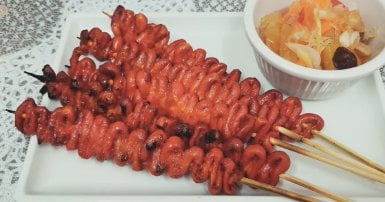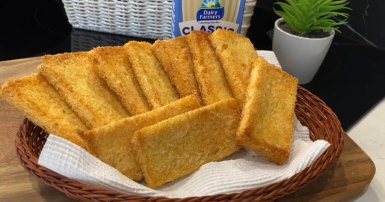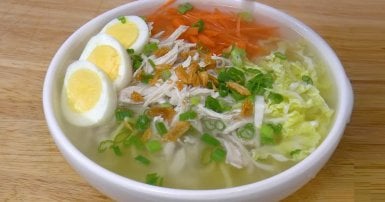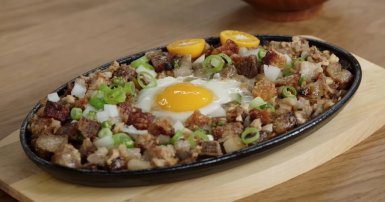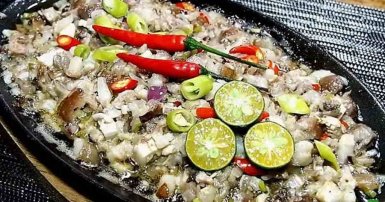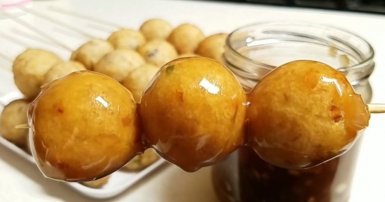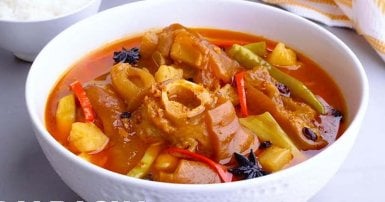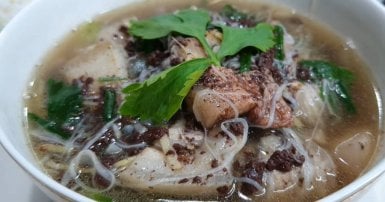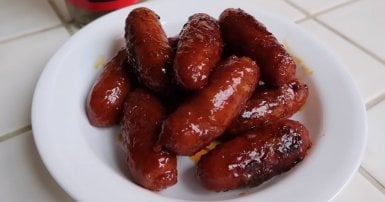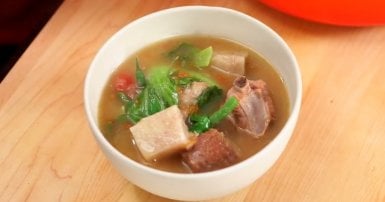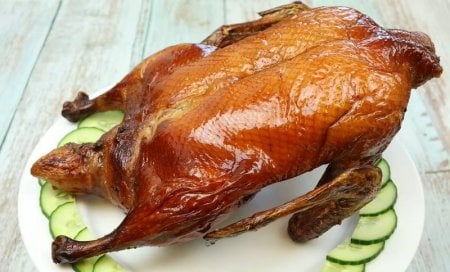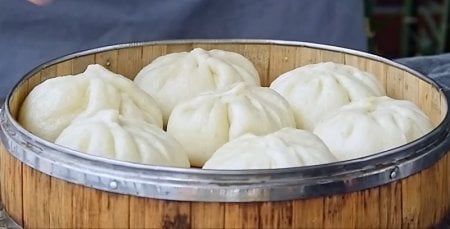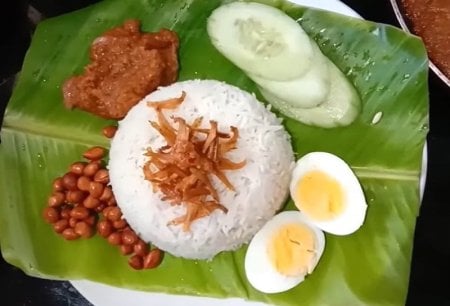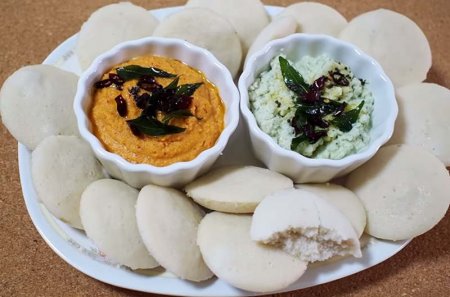Indulge in the sweet symphony of Philippine desserts, where each treat is a delectable blend of flavors, textures, and cultural influences. Philippine desserts, or "kakanin," reflect the nation's diverse culinary heritage, drawing inspiration from indigenous ingredients and Spanish, Chinese, and American influences. From the creamy decadence of leche flan to the sticky sweetness of bibingka and the tropical delight of halo-halo, these desserts offer a tantalizing journey through the Philippines' rich gastronomic landscape.
Leche Flan
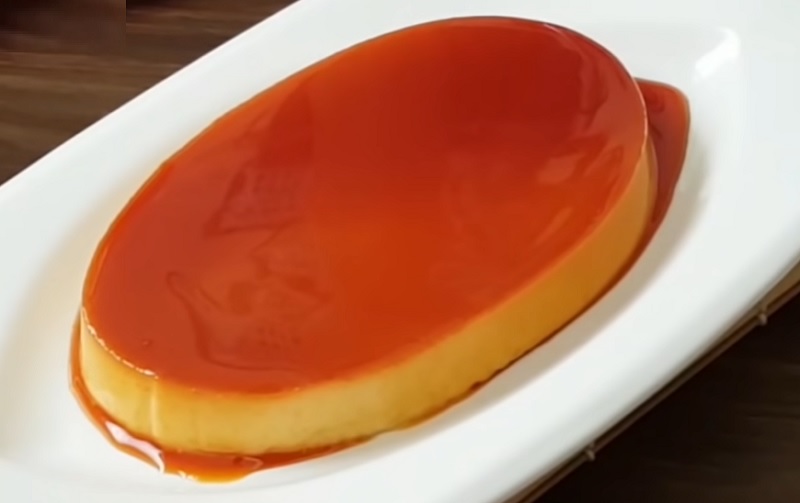
Leche flan, also known as Crème caramel, is a popular and classic Filipino dessert. It is a rich and creamy custard dish made with eggs, milk, sugar, and vanilla extract. The dessert is typically prepared by caramelizing sugar in a mold, then pouring the silky custard mixture over it. It is then baked in a water bath until the custard sets and becomes firm. The resulting leche flan is a delectable combination of smooth and velvety custard with a luscious caramel sauce. It has a delicate sweetness and a hint of vanilla, creating a perfect balance of flavors. The creamy texture of the custard melts in your mouth, while the caramel sauce adds a rich and slightly bitter sweetness. Leche flan is often served chilled, allowing the flavors to develop and intensify. It is commonly enjoyed as a dessert or as a sweet treat after a meal.
Churro
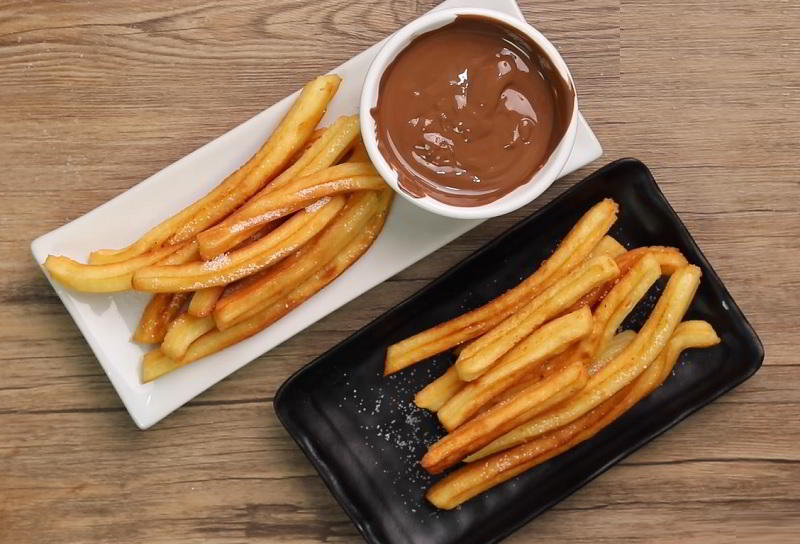
Churro is a popular dessert in the Philippines that originated from Spain. It is a deep-fried dough pastry that is typically served with a variety of toppings and dips. The dough is made by mixing flour, water, and a pinch of salt, which is then piped through a star-shaped nozzle and fried until golden brown. The result is a crispy and slightly chewy pastry that is delicious on its own, but even better when paired with different flavors. In the Philippines, churros are often coated in sugar and cinnamon, giving them a sweet and aromatic taste. They are commonly served with a side of warm chocolate dip, which adds a rich and creamy element to the dish. Other popular toppings and dips include caramel, condensed milk, and flavored syrups.
Halo-halo
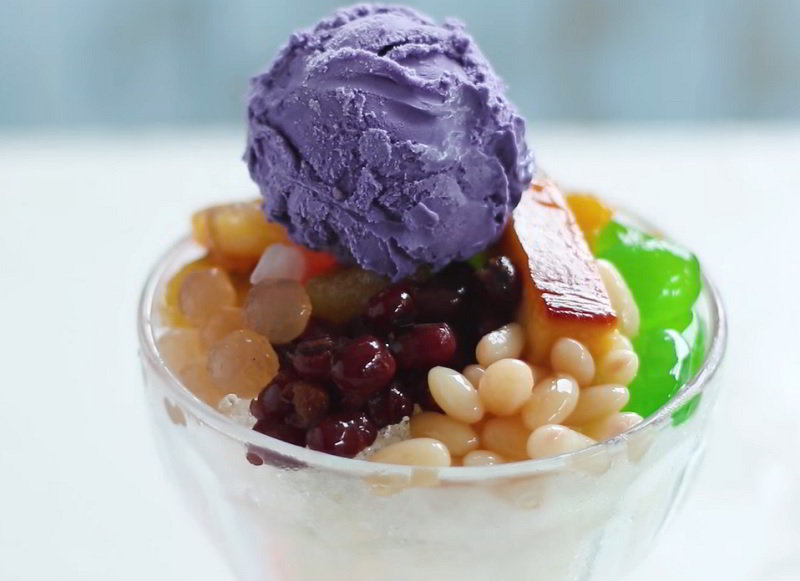
Halo-halo is a popular and refreshing Filipino dessert that literally translates to "mix-mix" in English. It is a delightful concoction of various ingredients that are layered and then mixed together before eating. This dessert is perfect for hot and humid weather in the Philippines. The base of halo-halo is usually made with crushed ice and sweetened beans such as kidney beans, chickpeas, and red mung beans. It is then topped with a variety of sweet ingredients like sweetened fruits (such as bananas, jackfruit, and coconut), gelatin cubes, sweetened corn, and leche flan (a caramel custard). Some versions also include a scoop of ube (purple yam) ice cream or ube halaya (purple yam jam). To enhance the flavors, evaporated milk is generously poured over the mixture, giving it a creamy and rich taste. Finally, it is served with a spoon and a straw, allowing you to enjoy both the crunchy and creamy elements of the dessert.
Turon (food)
-1704979920.jpg)
Turon is a delightful treat which consists of sweet plantain slices (saba bananas) wrapped in spring roll wrappers and deep-fried until they turn golden brown and crispy. To enhance its taste, the plantains are usually sprinkled with brown sugar and occasionally paired with jackfruit strips before being wrapped. Turon can be enjoyed as a midday snack or a dessert. Its crispy exterior delivers a satisfying crunch, while the soft and caramelized plantains inside provide a burst of natural sweetness. The unique combination of textures and flavors is what sets turon apart and makes it truly special.
Nata De Coco
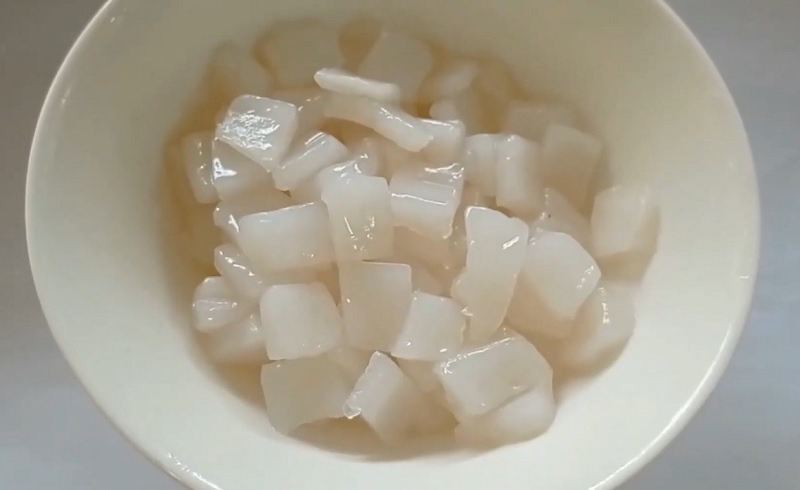
Nata de coco is a popular Philippine dessert known for its unique texture and refreshing taste. It is made from coconut water that has been fermented with the help of bacteria and then set into a gelatin-like substance. The resulting product is translucent and chewy, with a slightly sweet and tangy flavor. Nata de coco is commonly used as an ingredient in various desserts and beverages, adding a delightful twist to traditional Filipino sweets. It is often mixed with fruits like mango, lychee, or pineapple to create a colorful and flavorful dessert. It can also be enjoyed on its own, either as a snack or as a topping for ice cream or halo-halo, a popular Filipino ice-based dessert.
Gulaman
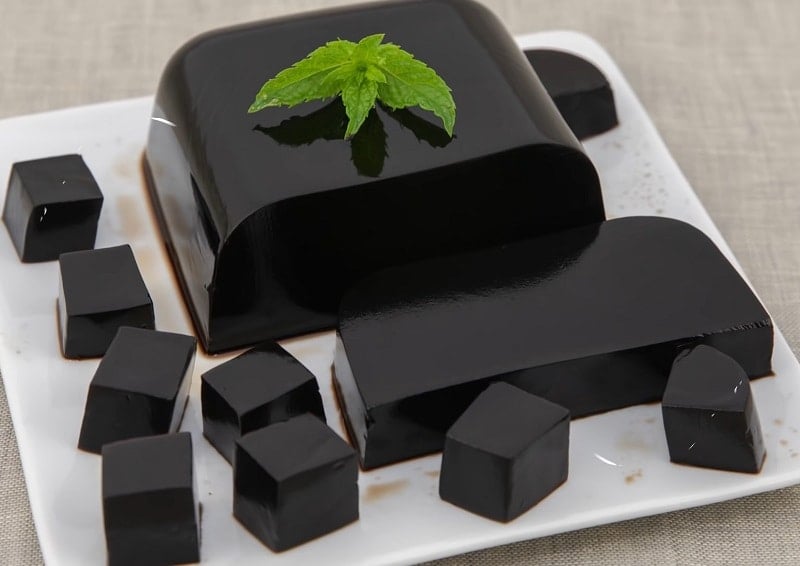
Gulaman is a refreshing and sweet dish made from the leaves of the Mesona chinensis plant, which are boiled until they release a thick and jelly-like substance. To prepare gulaman, the leaves are first cleaned and boiled in water. The resulting liquid is then strained to remove any impurities. Sugar is added to the liquid, giving it a sweet taste. The mixture is then left to cool and solidify, forming a dark and translucent jelly. Gulaman is typically served in a bowl or cup, often with additional ingredients such as sago pearls, tapioca balls, or fresh fruits. It can be enjoyed on its own or mixed with other desserts like halo-halo or ice cream.
Puto Bumbong
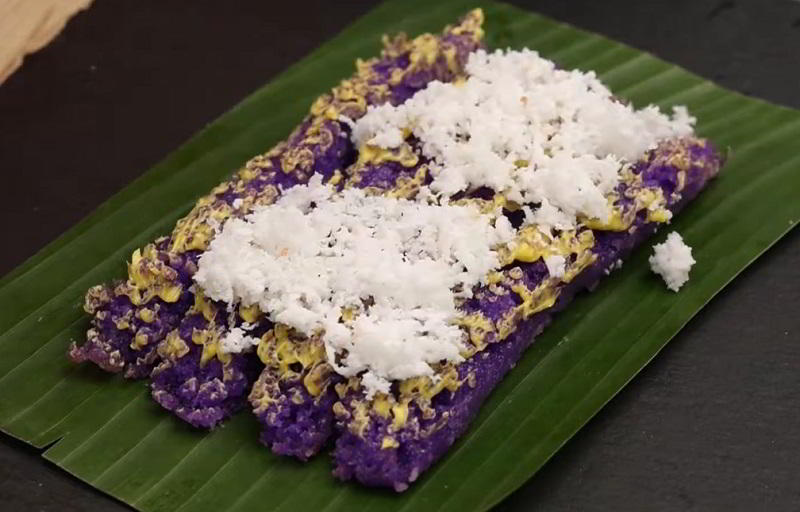
Puto bumbong is a traditional Filipino dessert that is popularly enjoyed during Christmas season and other festive occasions. It is made from glutinous rice that is soaked overnight, ground, and then steamed in bamboo tubes. The resulting purple-colored rice cakes are soft, sticky, and have a distinct flavor that is enhanced by the aroma of the bamboo. To prepare puto bumbong, the steamed rice cakes are traditionally served with a generous topping of butter or margarine, grated coconut, and muscovado sugar. The combination of flavors creates a delightful balance of sweet, savory, and nutty tastes. Some variations also include a sprinkle of toasted sesame seeds or a drizzle of condensed milk for added richness. The unique and vibrant purple color of puto bumbong comes from the use of "pirurutong" rice, which is a special variety of glutinous rice with a dark hue.
Alfajor
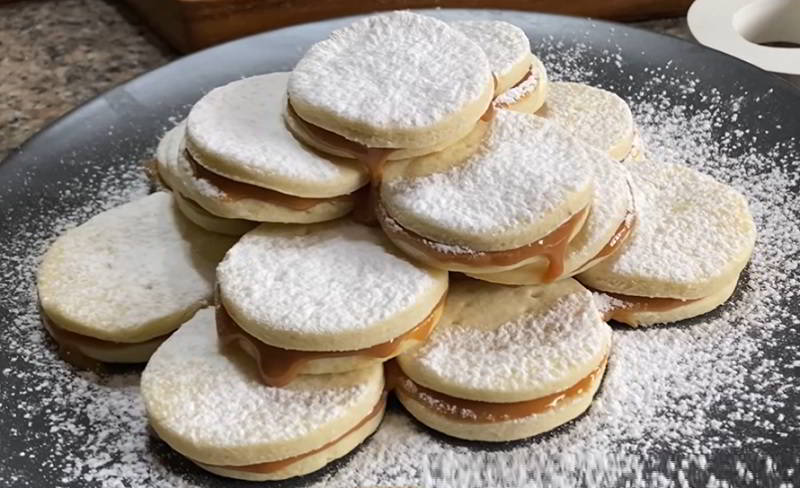
Alfajor is a delightful Filipino dessert that originated from Spain. It is a delectable treat made with two soft and crumbly cookies sandwiched together with a generous filling of dulce de leche or caramel. The cookies are typically made with a combination of flour, butter, and powdered sugar, resulting in a tender and melt-in-your-mouth texture. The filling is the star of the show in an Alfajor dish. Dulce de leche, a sweet and creamy caramel made from condensed milk, is spread generously between the cookies. The caramel adds a rich and indulgent flavor that perfectly balances the sweetness of the cookies. Alfajor is often enjoyed as a snack or dessert, especially during special occasions and holidays. It is commonly served with a dusting of powdered sugar on top, adding a touch of elegance to its appearance. Some variations of Alfajor include adding nuts, coconut flakes, or even chocolate drizzle for added texture and flavor.
Bibingka
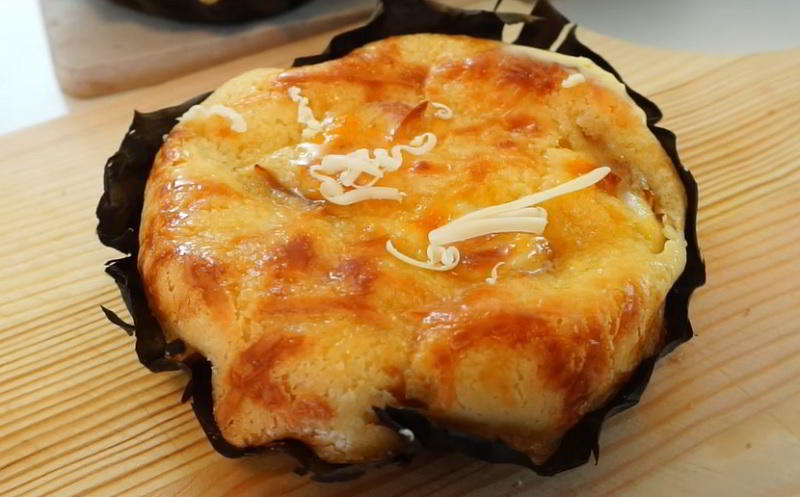
Bibingka is a traditional Philippine dessert that is popular during the Christmas season. It is a sweet and savory rice cake that is made with glutinous rice flour, coconut milk, eggs, and sugar. The batter is poured into a special clay pot called a bibingkaan, which is lined with banana leaves to add a distinct aroma and flavor. Once the batter is poured into the pot, it is then topped with salted duck eggs, grated coconut, and sometimes cheese or butter. The pot is placed over hot coals or in a preheated oven and cooked until the cake is golden brown and slightly crispy on the outside, with a soft and moist interior. Bibingka is often enjoyed with a side of grated coconut and eaten while still warm. It has a unique taste that combines the richness of coconut milk with the subtle sweetness of the cake and the saltiness of the salted duck eggs.
Ube Halaya
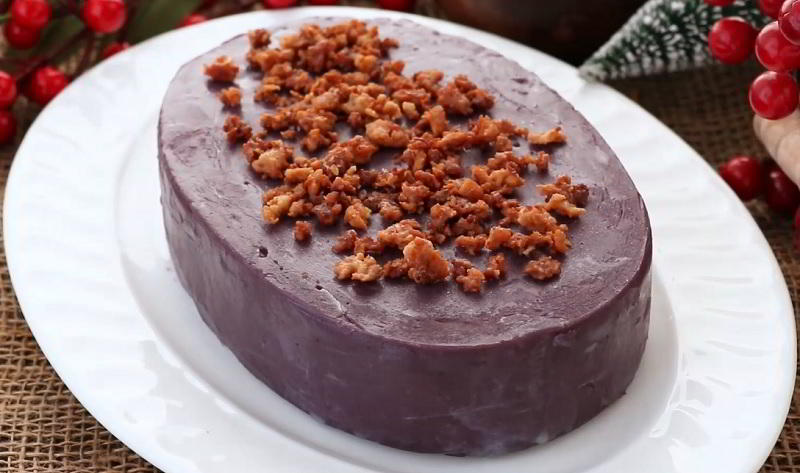
Ube halaya is a delicious and popular Filipino dessert made from purple yam, locally known as ube. This vibrant dessert is a sweet and creamy pudding-like dish that is beloved by many Filipinos. To make ube halaya, the purple yam is first boiled until tender, then mashed or grated to create a smooth and silky texture. The mashed yam is then combined with coconut milk, condensed milk, and butter, and cooked over low heat until it thickens and becomes a sticky and rich mixture. The resulting ube halaya has a distinct purple color and a delightful aroma. It has a sweet and earthy flavor that is uniquely Filipino, with hints of coconut and vanilla. Ube halaya is often enjoyed as a standalone dessert, but it can also be used as a filling for pastries and cakes.
Polvorón

Polvorón is a popular Filipino dessert that is loved for its crumbly and melt-in-your-mouth texture. This delectable dessert is made with a few basic ingredients such as toasted flour, powdered milk, sugar, and butter. The ingredients are mixed together and shaped into small, bite-sized cakes or patties. Traditionally, polvorón is wrapped in colorful cellophane or papel de japon (Japanese paper) to enhance its presentation. The flavor of polvorón can vary, with some variations including additional ingredients like crushed cookies, nuts, or flavors such as chocolate or ube (purple yam). Each bite of polvorón provides a delightful combination of sweetness, buttery richness, and a delicate crumbly texture.
Maruya
-1704979798.jpg)
Maruya is a popular dessert in the Philippines characterized by its deep-fried goodness and delightful sweetness. It is a simple yet delicious dish made from ripe bananas that are mashed and mixed with flour, sugar, and milk to form a batter. The batter is then spooned into hot oil and fried until golden brown. What sets Maruya apart from other banana fritters is its light and fluffy texture. The combination of the mashed bananas and the batter creates a soft and moist interior, while the outer layer becomes crispy and slightly caramelized. Maruya is often enjoyed as a snack or a dessert, and it is commonly served with a sprinkle of sugar on top or a drizzle of honey.
Suman
-1702280639.jpg)
Suman is a traditional Filipino dessert that is loved by many. It is a sticky rice cake wrapped in banana leaves and steamed to perfection. The process of making Suman involves soaking glutinous rice overnight, then grinding it into a smooth paste. This paste is mixed with coconut milk, sugar, and a pinch of salt to enhance the flavor. Once the mixture is ready, it is carefully wrapped in banana leaves, giving it a unique aroma and flavor. The wrapped suman is then steamed until it becomes firm and sticky. It is often served with a sweet coconut sauce or sprinkled with sugar and grated coconut.
Piaya
-1707733728.jpg)
Piaya is a delectable Filipino dessert that originated from the province of Negros Occidental in the Philippines. It is a sweet, flatbread filled with a sweet mixture of muscovado sugar and molasses. This delightful delicacy is often enjoyed as a snack or dessert. The dough of the piaya is made from flour, water, and sometimes lard or oil, giving it a soft and chewy texture. The filling, which is the highlight of this dessert, is made by cooking muscovado sugar and molasses until it becomes thick and sticky. This caramel-like mixture is then generously spread onto the dough before folding it into a round shape. Piaya is traditionally cooked over a hot griddle until it turns golden brown and slightly crispy on the outside.
Kalamay
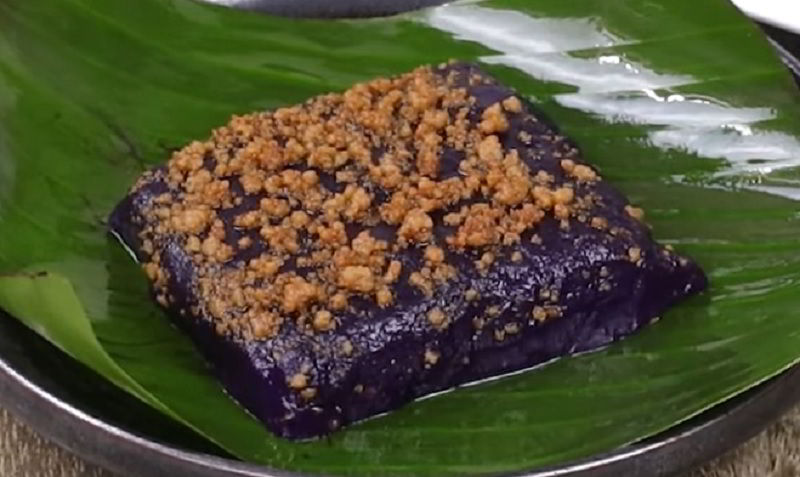
Kalamay is a traditional Filipino delicacy that is loved for its sticky and sweet flavor. It is a sticky rice cake made from glutinous rice, coconut milk, and brown sugar. The dish is usually cooked by slowly simmering the ingredients until the rice grains are fully cooked and the mixture becomes thick and sticky. What sets Kalamay apart from other Filipino desserts is its unique texture and distinct flavor. The glutinous rice gives it a chewy consistency, while the coconut milk adds richness and creaminess. The brown sugar adds a caramel-like sweetness that complements the natural flavors of the rice and coconut. Kalamay is often enjoyed as a snack or dessert, especially during special occasions and holidays. It is commonly served on banana leaves and topped with latik, which is a sweet coconut sauce made from coconut cream and brown sugar.
Dodol
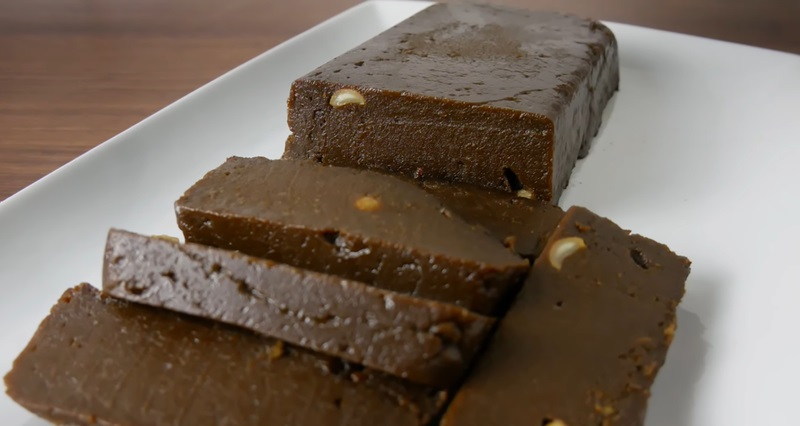
Dodol is a traditional Philippine dessert that has a rich and chewy texture, making it a favorite among locals and tourists alike. This sweet treat is made from a combination of coconut milk, sticky rice flour, and palm sugar. The ingredients are mixed together and cooked slowly over low heat until they form a thick and sticky consistency. Dodol is typically flavored with pandan leaves, which give it a distinct aroma and a vibrant green color. Other variations include flavors like chocolate, durian, and peanut. Once the mixture is cooked, it is poured into molds or banana leaves and left to cool and set. The chewy texture of the dodol is complemented by the creamy and coconutty flavors, creating a truly indulgent experience.
Banana Chip
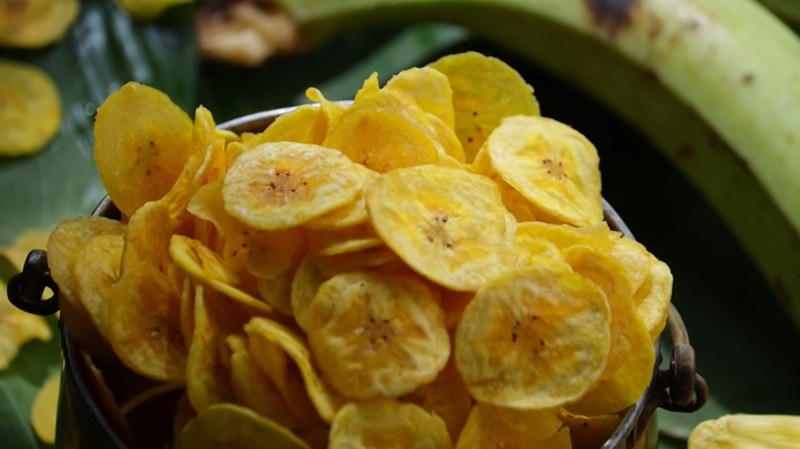
Banana chip is a popular Filipino dessert that showcases the sweet and crispy goodness of bananas. It starts with ripe bananas that are thinly sliced and then deep-fried until they become golden and crispy. The result is a delightful snack that is both crunchy and chewy. The bananas used for this dessert are typically the saba variety, known for their rich flavor and creamy texture. The slices are usually coated in a thin layer of sugar or honey before frying, adding a touch of sweetness to the already delicious bananas. Banana chip dish is often enjoyed as a snack on its own, but it can also be used as a topping for other desserts like ice cream or halo-halo. Some variations of this dish even incorporate other ingredients such as caramel or chocolate drizzle to further enhance the flavors.
Ube Ice Cream
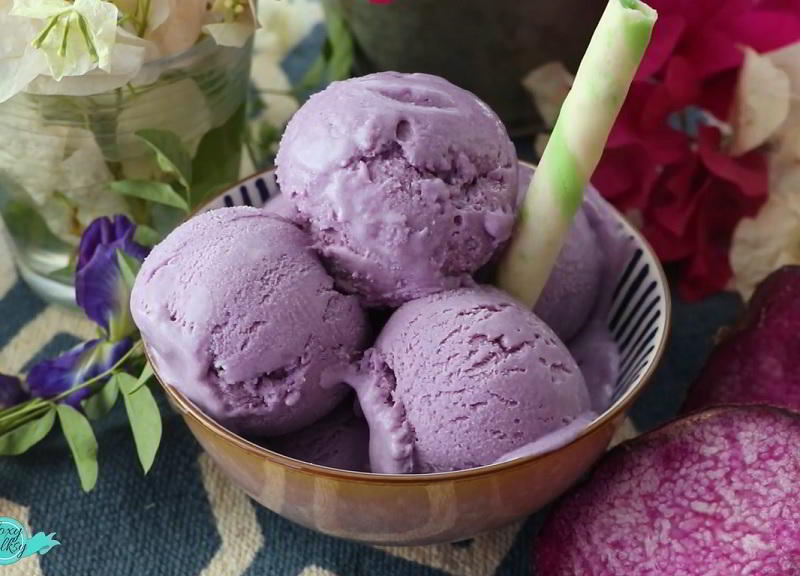
Ube ice cream is made from a vibrant purple yam called ube, which is known for its unique flavor and color. The yam is cooked, mashed, and combined with condensed milk, sugar, and coconut milk to create a creamy and velvety ice cream base. What sets ube ice cream apart is its striking purple hue, which is all-natural and derived from the yam itself. This eye-catching color adds to the overall appeal of the dessert. The taste is sweet and nutty, with hints of vanilla and coconut that complement the natural earthiness of the yam.
Lugaw

Lugaw, a popular Filipino dessert, is a sweet rice porridge that is widely enjoyed in the Philippines. It is a comforting and satisfying dish that is often served as a snack or dessert. The main ingredient of lugaw is glutinous rice, which gives it a sticky and creamy texture. To prepare lugaw, the glutinous rice is cooked in coconut milk, water, and sugar until it becomes soft and tender. The dish is then flavored with pandan leaves, which adds a fragrant and refreshing taste. Sometimes, additional ingredients such as sweet potatoes, bananas, or jackfruit are added to enhance the flavor and texture of the dish. Lugaw is traditionally served warm and can be enjoyed on its own or paired with other Filipino desserts such as halo-halo or bibingka.
Maja Blanca
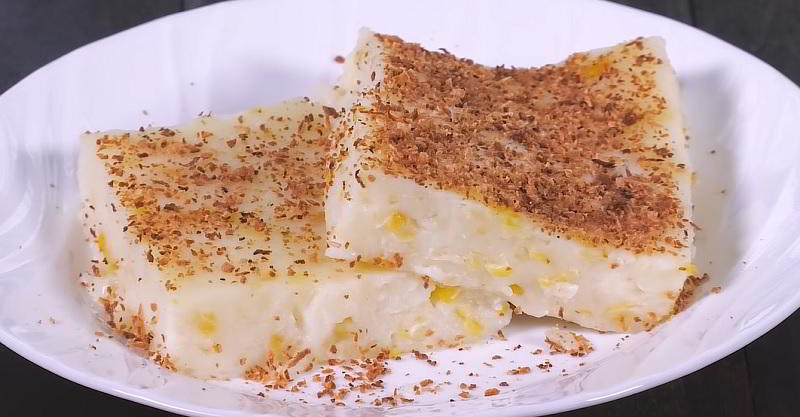
Maja blanca is a popular Filipino dessert that originated from the province of Bohol in the Philippines. It is a creamy and delicious treat made primarily from coconut milk, cornstarch, sugar, and corn kernels. The name "maja blanca" translates to "white corn pudding," which perfectly describes its appearance. To make maja blanca, coconut milk is first heated and combined with sugar to create a sweet base. Corn kernels are then added to the mixture, providing a delightful crunch and burst of flavor. Cornstarch is used as a thickening agent, giving the dessert its smooth and creamy texture. Once the mixture has thickened, it is poured into molds or a baking dish to set. Maja blanca is typically served chilled and can be garnished with latik, which is made from coconut milk and sugar that has been simmered until it forms brown granules.
Banana Cue
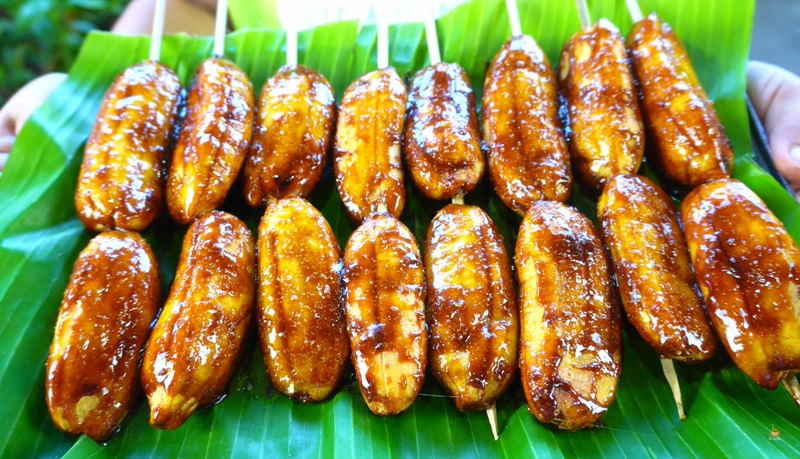
Banana cue is a simple yet delicious treat made with ripe saba bananas, brown sugar, and cooking oil. The name "banana cue" is derived from the combination of the words "banana" and "barbecue," as the bananas are skewered and cooked in a similar manner to barbecued meat. To make banana cue, the saba bananas are peeled and then coated in brown sugar. They are then skewered on bamboo sticks and deep-fried until the sugar caramelizes and forms a sweet and crunchy coating. The result is a mouthwatering combination of soft and sweet bananas with a caramelized exterior.
Ampaw
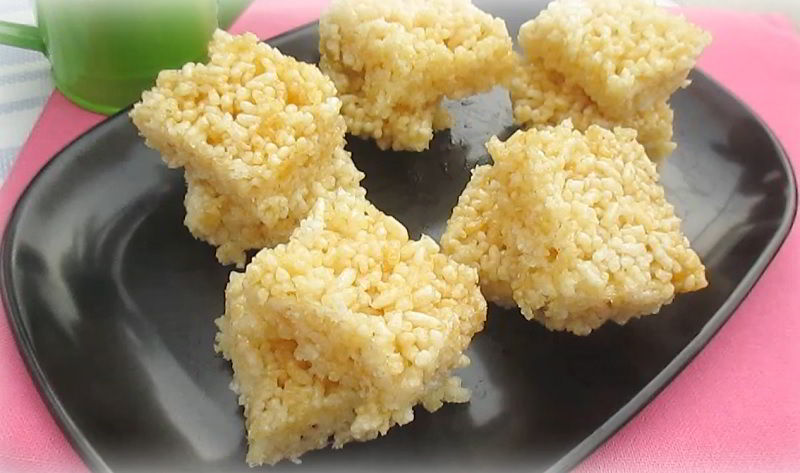
Ampaw is a traditional Filipino dessert that has been enjoyed for generations. It is a sweet and crunchy treat made from glutinous rice that is cooked until it puffs up and becomes light and airy. The process involves soaking the rice overnight and then spreading it out to dry before it is cooked. Once cooked, the rice is allowed to cool and harden, resulting in a crispy texture that is reminiscent of a rice cracker. Ampaw can be enjoyed on its own as a snack or used as a topping for other desserts. It is often sprinkled over halo-halo, a popular Filipino dessert made with shaved ice, sweet beans, jellies, and fruits. The combination of the soft and sweet halo-halo with the crunchy and slightly salty ampaw creates a delightful contrast of textures and flavors.
Mamón
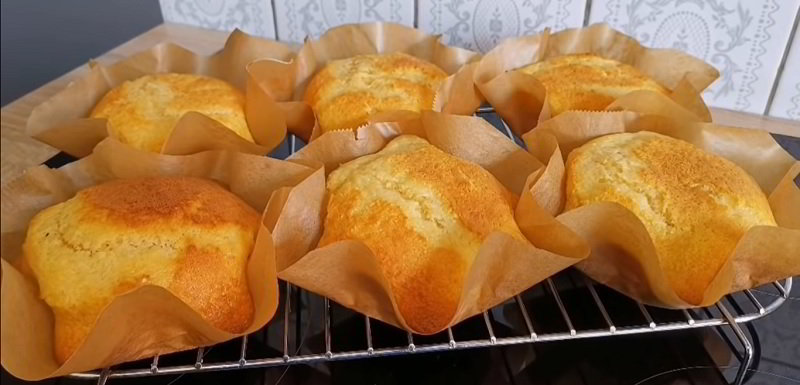
Mamón is a popular Philippine dessert that is loved for its light and fluffy texture. This delectable treat is made from simple ingredients such as eggs, sugar, flour, and butter, but the result is a soft and spongy cake that melts in your mouth. The cake is typically baked in individual molds, giving it a charming and elegant appearance. It is often topped with a sprinkling of sugar or a dusting of powdered sugar to add a touch of sweetness. One of the defining features of Mamón is its delicate flavor. The cake has a subtle vanilla taste that is not overpowering, making it a versatile dessert that can be enjoyed on its own or paired with other flavors.
Kiamoy

Kiamoy is a Filipino dessert made from prunes, dried sour plums, or apricots that have been preserved in vinegar and brine. These fruits are then coated in a powdery mixture of licorice, anise, li hing, sugar, and salt, giving them their distinct red, orange, or light brown color. This delicious treat has its roots in the Chinese Filipino community and is reminiscent of the li hing mui treats found in Chinese cuisine. The name "kiamoy" comes from the Philippine Hokkien Chinese term for "salted plum."
Pastillas
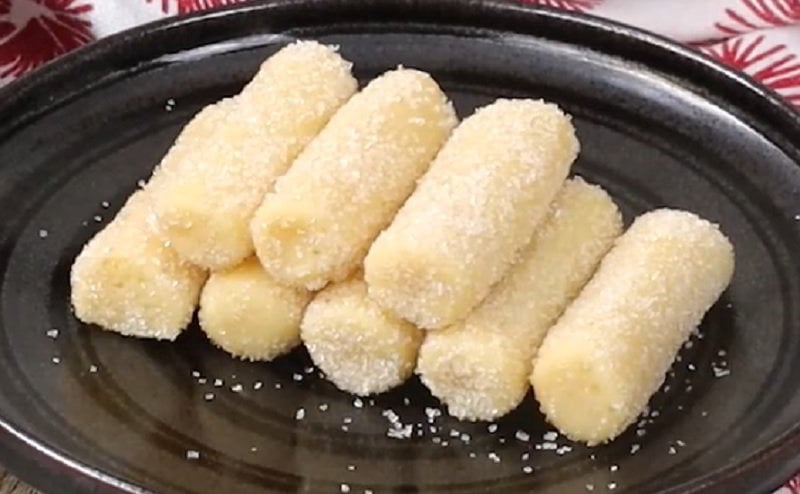
Pastillas is a sweet and creamy treat made from a simple combination of only two main ingredients: condensed milk and powdered milk. To make pastillas, condensed milk and powdered milk are mixed together until a smooth dough-like consistency is achieved. The mixture is then rolled into small cylindrical shapes and coated with sugar to prevent sticking. The result is a soft and chewy candy that melts in your mouth. Pastillas is often flavored with different variations such as chocolate, langka (jackfruit), yema (caramel), and ube (purple yam), adding a delightful twist to the classic treat.
Pionono
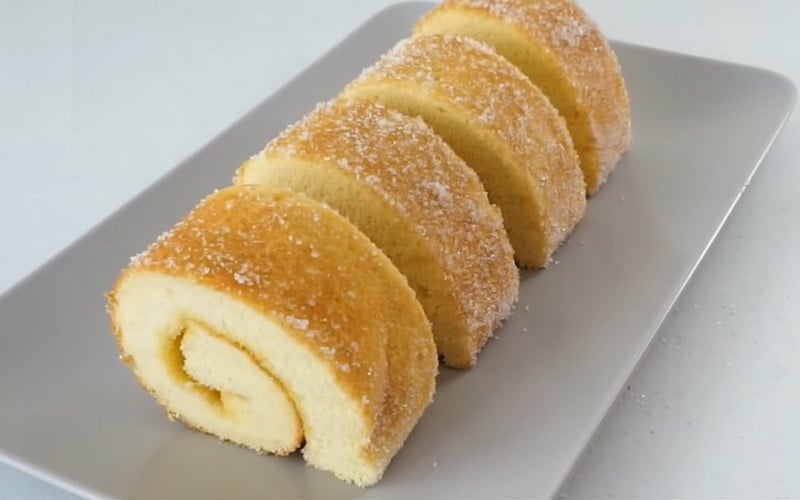
Pionono, also known as "Pianono," is a delectable Filipino dessert that is loved for its soft and spongy texture. It is a rolled cake made from a simple batter of eggs, flour, sugar, and vanilla extract. The batter is spread thinly on a baking sheet and baked until golden brown. Once baked, the cake is removed from the oven and carefully rolled while still warm to create its signature cylindrical shape. The filling is what truly sets Pionono apart. It can be a variety of different flavors like sweetened condensed milk, jam, or even chocolate spread. Some versions even incorporate fresh fruits like sliced bananas or strawberries.
Buko Pie
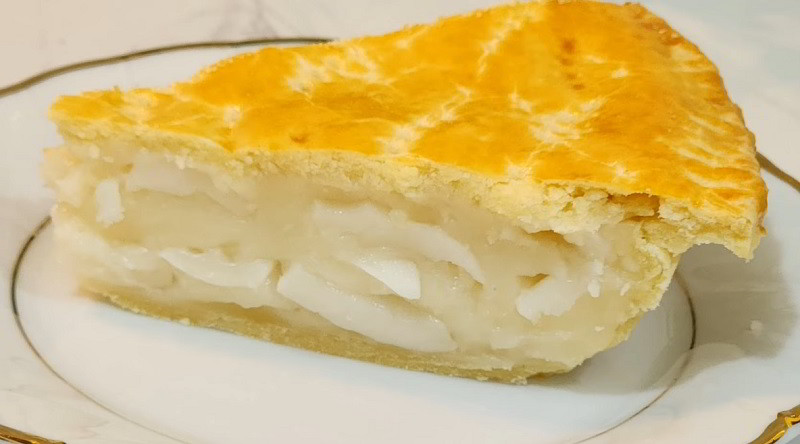
Buko pie is a popular Filipino dessert that originates from the province of Laguna in the Philippines. It is a delectable pastry filled with a creamy and luscious mixture of young coconut meat and a sweet custard-like filling. The crust of the pie is typically made from a flaky and buttery dough, giving it a crisp texture that complements the smoothness of the filling. The star ingredient, buko or young coconut, is harvested when the coconut is still tender and the meat is soft and jelly-like. The fragrant flavor of the coconut combined with the sweetness of the custard creates a harmonious blend.
Cassava Cake
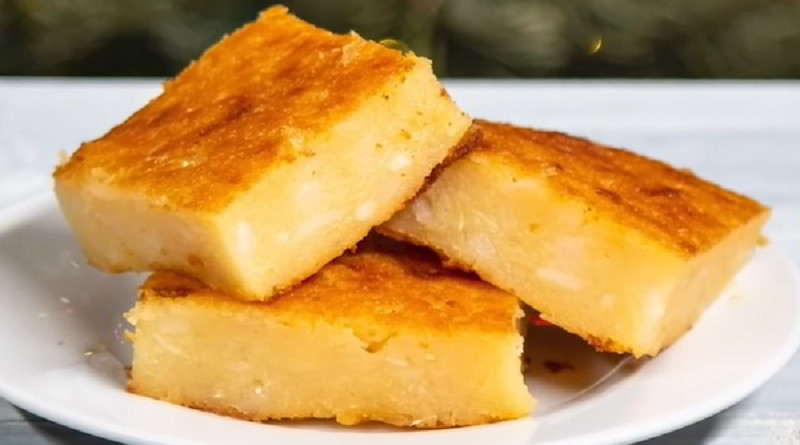
Cassava cake is a popular Filipino dessert known for its rich, creamy, and slightly chewy texture. This delightful dish is made primarily from grated cassava, a starchy root vegetable commonly found in the Philippines. The grated cassava is mixed with coconut milk, condensed milk, eggs, and sugar, creating a sweet and luscious batter. The mixture is then poured into a baking dish and baked until it sets and turns golden brown on top. Once cooked, the cassava cake is often topped with a creamy coconut custard, adding a layer of indulgence to the already decadent dessert. Some variations also include toppings such as grated cheese or desiccated coconut for added flavor and texture.
Yema
-1707751031.jpg)
Yema is a popular Filipino candy that is loved by both children and adults. It is a sweet and creamy treat that is made from just a few simple ingredients - condensed milk and egg yolks. The mixture is cooked over low heat until it thickens and becomes sticky, and then it is shaped into small balls or rolled into bite-sized pieces. Yema has a smooth and velvety texture that melts in your mouth, and its rich and sweet flavor is truly addictive. Some variations of yema include adding flavors like vanilla or ube (purple yam) to give it a unique twist.
Mango Float
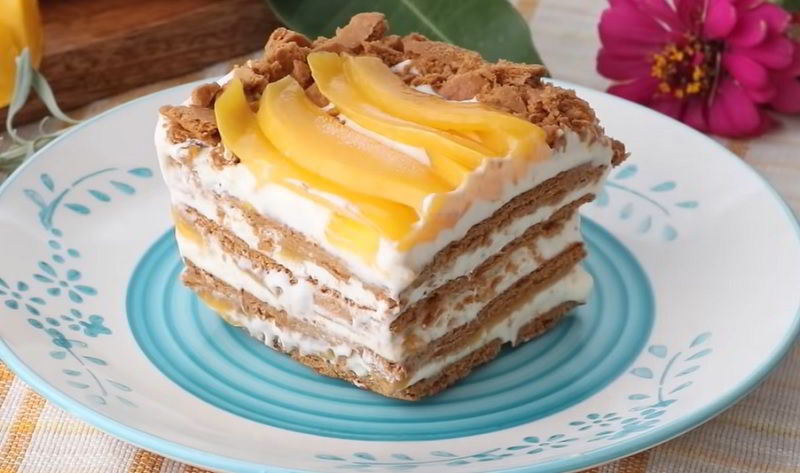
Mango float is a no-bake dessert that is made by layering graham crackers, whipped cream, and slices of ripe mangoes. The graham crackers provide a crunchy and slightly sweet base, while the whipped cream adds a light and fluffy texture. The star of the dish, the ripe mangoes, bring a burst of tropical sweetness and a vibrant yellow color. To make mango float, the graham crackers are soaked in milk to soften them before being arranged in a single layer in a baking dish. A layer of whipped cream is then spread over the graham crackers, followed by a layer of sliced mangoes. This process is repeated, creating multiple layers of deliciousness. The dessert is then chilled in the refrigerator for a few hours to allow the flavors to meld together and the graham crackers to soften further. Mango float is a delightful dessert that is perfect for hot summers and special occasions. Its combination of creamy, fruity, and crunchy elements makes it a refreshing and satisfying treat that is enjoyed by many Filipinos and dessert lovers alike.
Sans Rival
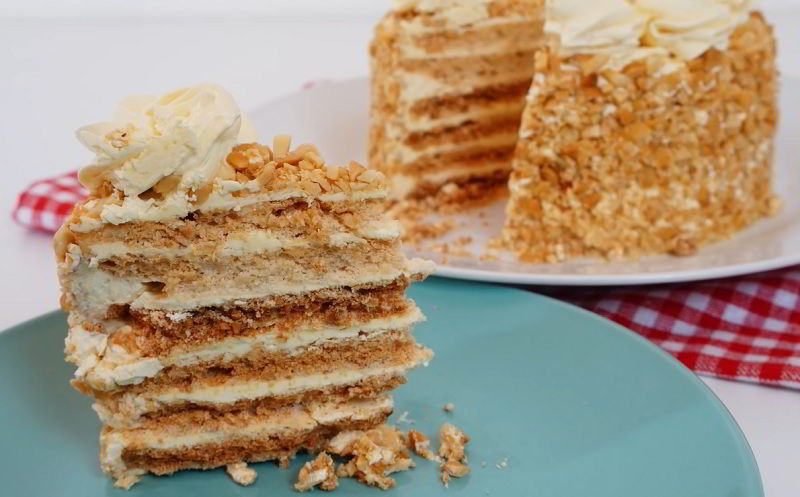
Sans rival is a delectable Filipino dessert that is rich, sweet, and absolutely unforgettable. This mouthwatering treat consists of layers of meringue, buttercream, and crushed cashews, creating a delightful mix of flavors and textures. The meringue layers are made using egg whites and sugar, resulting in a light and crispy base that provides the perfect foundation for the dessert. In between the meringue layers is a luscious buttercream filling, which is made by combining butter, sugar, and egg yolks until creamy and smooth. This creamy filling adds a velvety richness to each bite. To add an extra touch of indulgence, crushed cashews are sprinkled on top of the buttercream layer, providing a delightful crunch and nutty flavor that perfectly complements the sweetness of the meringue and buttercream.
Tibok-tibok
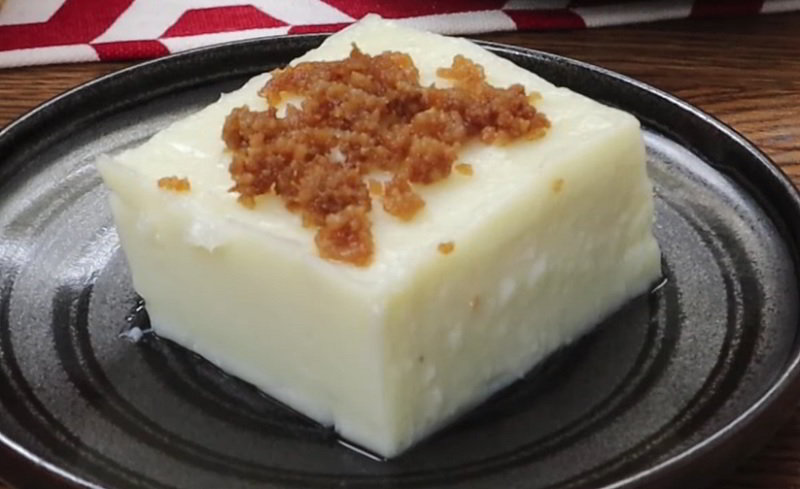
Tibok-tibok is a traditional Filipino dessert hailing from the province of Pampanga in the Philippines. This delectable dish is made from carabao's milk, a type of water buffalo milk known for its rich and creamy texture. The name "tibok-tibok" is derived from the Tagalog word "tibok" which means heartbeat, as the dessert resembles the texture of a beating heart. To make tibok-tibok, carabao's milk is cooked together with toasted rice flour, sugar, and cornstarch until it thickens to a custard-like consistency. It is then poured into molds and allowed to cool and set. The final result is a smooth and silky dessert with a slightly sweet and milky flavor. Tibok-tibok is often garnished with latik, a traditional topping made from simmering coconut cream until it thickens and forms golden brown coconut curds. This adds a delightful crunch and coconut flavor to the dish.
Biscocho
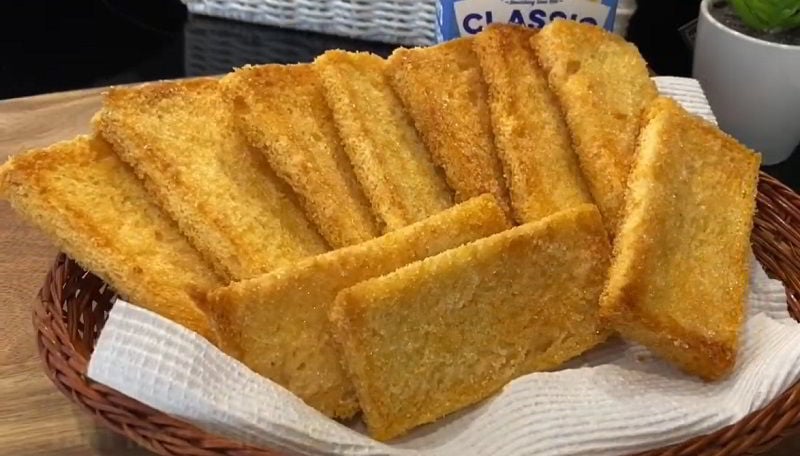
Biscocho is a traditional Filipino dessert that is loved for its sweet and crunchy texture. It is made from slices of day-old bread that are baked until they become crisp and golden brown. The bread slices are then generously coated with butter and sprinkled with sugar, creating a delightful caramelized flavor. This delightful treat is often enjoyed as a snack or dessert, and it pairs perfectly with a cup of coffee or tea.
Tupig
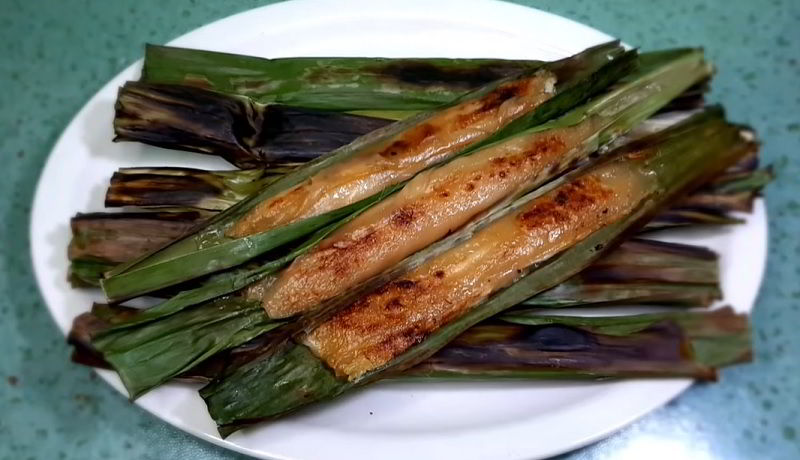
Tupig is a traditional Filipino dessert commonly found in the northern regions of the Philippines, particularly in the Ilocos region. It is a sweet and sticky rice cake made from glutinous rice, coconut milk, and grated young coconut meat. To make tupig, the glutinous rice is soaked overnight and then ground to a coarse texture. It is then mixed with coconut milk, sugar, and grated coconut meat. The mixture is wrapped in banana leaves and grilled over charcoal or an open flame until it becomes golden brown and crispy on the outside. What sets tupig apart from other Filipino desserts is its unique texture and smoky flavor imparted by the grilling process. The outer layer of the rice cake becomes slightly charred and crunchy, while the inside remains soft and chewy. The combination of the sweet, sticky rice and the fragrant coconut adds a delightful tropical taste to this delectable treat.
Ube Cake

Ube cake is a popular Filipino dessert that showcases the vibrant purple yam known as ube. This delectable treat is made with moist and fluffy cake layers infused with the distinct flavor of ube, creating a unique and delightful dessert experience. The cake itself is usually made with a combination of ube extract or powder, flour, eggs, sugar, and butter. The ube flavor adds a subtle sweetness and earthy undertones, giving the cake its distinctive taste. The layers are often filled with a luscious ube jam or custard, adding an extra burst of flavor and a creamy texture. To enhance the visual appeal, the cake is typically frosted with a light and creamy purple-hued icing, adding to the allure of this dessert.
Biko
-1707802246.jpg)
Biko is a popular Filipino dessert that is made from glutinous rice, coconut milk, and brown sugar. I The dish has a sticky and chewy texture, with a sweet and creamy flavor. To make biko, glutinous rice is cooked with coconut milk and brown sugar until it becomes sticky and fully absorbed. The mixture is then spread onto a baking dish and topped with latik, which is made from simmering coconut cream until it forms golden brown curds. The latik adds a rich and caramelized flavor to the biko. Biko is typically served in small squares or rectangles and is enjoyed as a snack or dessert. It is often garnished with grated coconut or sprinkled with toasted sesame seeds for added texture and taste. The combination of the sticky rice, creamy coconut milk, and sweet caramelized sugar makes biko an irresistible treat for those with a sweet tooth.
Sorbetes
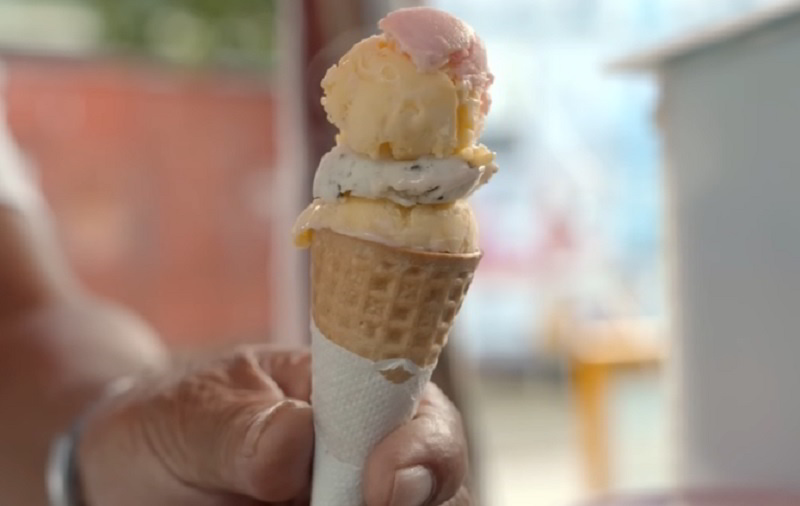
Sorbetes is a popular Filipino dessert that is often referred to as the local version of ice cream. This sweet treat traces its roots back to the Spanish colonial period in the Philippines. Traditionally made with coconut milk, carabao milk, or a combination of both, sorbetes is a creamy and refreshing dessert that comes in a variety of flavors. Some of the most common flavors include ube (purple yam), mango, chocolate, and cheese. Sorbetes is typically served on a small wafer or in a bread bun called "pandesal," making it convenient to enjoy on-the-go.
Binatog
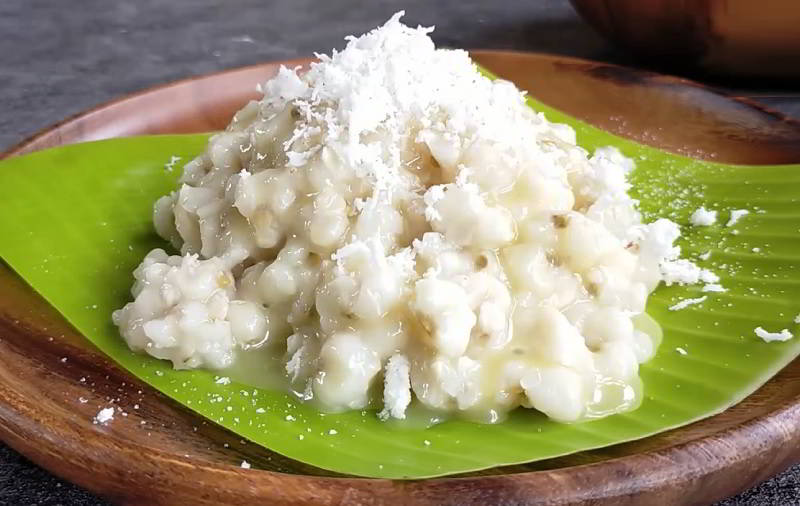
Binatog is a popular and delicious dessert made from boiled white corn kernels, which are then mixed with grated coconut and sugar. The corn kernels are cooked until they become tender and are then drained. The grated coconut is then added to the corn kernels, along with a generous amount of sugar to give it a sweet taste. Binatog is often served in small cups or bowls, making it a perfect snack or dessert option. It is typically enjoyed during the afternoon or as a street food treat.
Bukayo
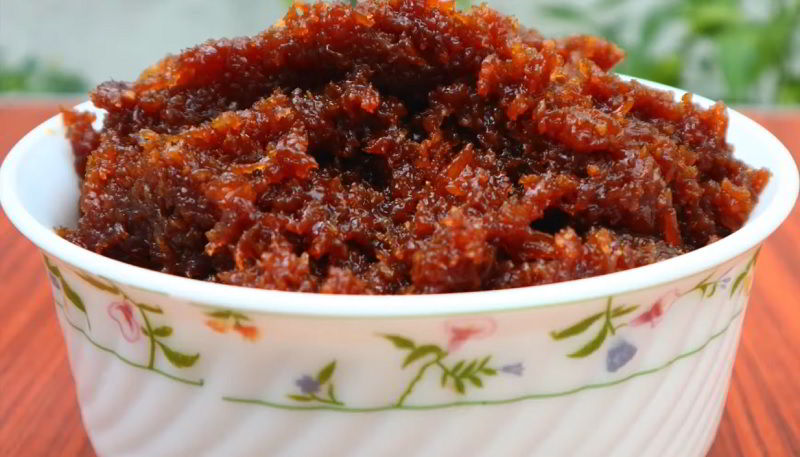
Bukayo is a traditional Filipino dessert made from coconut strips sweetened with sugar. The traditional method involves simmering young coconut strips (known as buko) in water along with sinuklob, a type of sugarcane muscovado melted to form a chewy caramel-like syrup. Variations of bukayo with a drier, crumbly texture are called bocarillo. Typically enjoyed rolled into small balls, bukayo can be savored as a standalone delight.
Moron
-1707805550.jpg)
Moron is a traditional Filipino dessert that originates from the province of Leyte in the Philippines. It is a glutinous rice-based delicacy that is wrapped in banana leaves and steamed until cooked. The name "moron" is derived from the local language, Waray, which means "chocolate" or "chocolate-flavored." The main ingredient of moron is malagkit, or glutinous rice, which gives it its distinct sticky and chewy texture. It is mixed with coconut milk and sugar, and sometimes flavored with cocoa powder or melted chocolate to give it a rich and indulgent taste. The mixture is then carefully wrapped in banana leaves, which adds a subtle aroma and imparts a unique earthy flavor to the dessert.
Kutsinta
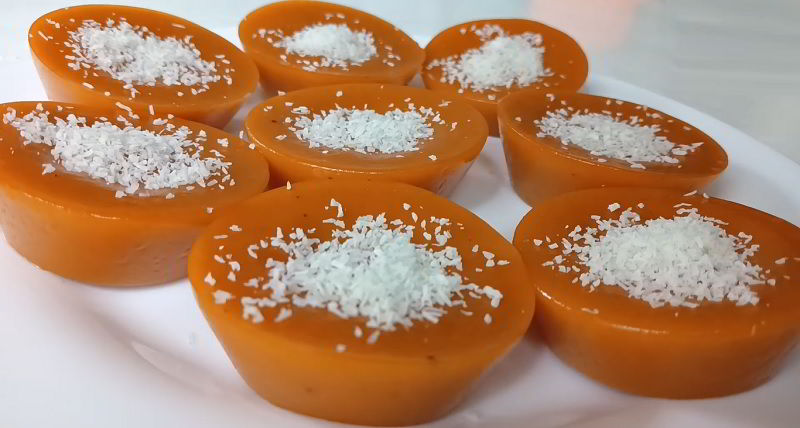
Kutsinta is a popular Filipino dessert that is loved for its sticky and chewy texture. It is made primarily from rice flour, brown sugar, and lye water, giving it a distinct flavor and color. The mixture is then steamed in small cupcake molds, resulting in small, round, and slightly translucent delicacies. The unique texture of kutsinta is what sets it apart from other Filipino desserts. It is soft and sticky, yet firm enough to hold its shape. The mildly sweet taste of brown sugar adds a delightful caramel-like flavor to each bite.
Binignit

Binignit is a traditional Filipino dessert known for its sweet and creamy taste. It is made with a variety of root crops such as sweet potato, taro, and purple yam, which are cooked in coconut milk, sugar, and water until tender and flavorful. Saba bananas, jackfruit and tapioca pearls are also added to enhance the taste and texture of the dish. Binignit is typically served warm and is often enjoyed as a mid-afternoon snack or as a dessert after a hearty Filipino meal. The combination of the different root crops creates a unique and delightful taste, while the creamy coconut milk adds richness to the dish. The sweetness of the sugar and the natural sweetness of the fruits make it a satisfying treat for those with a sweet tooth. .
Brazo de Mercedes
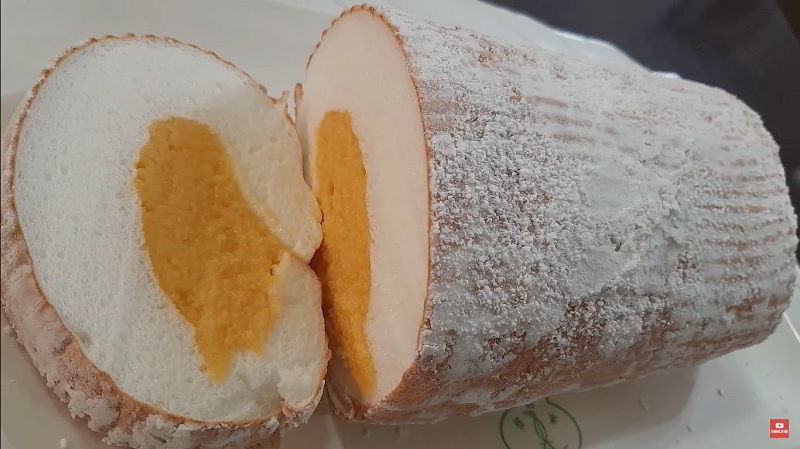
Brazo de Mercedes is a popular Filipino dessert known for its delicate and indulgent taste. Literally translating to "arm of Mercedes," this dessert is named after a Spanish dance that resembles the rolled shape of the dish. The main components of Brazo de Mercedes are a soft meringue roll and a rich custard filling. The meringue is made from egg whites and sugar, whipped to form a light and fluffy texture. It is then baked until it turns golden brown, creating a crisp outer layer that contrasts with the soft and airy interior. The custard filling, also known as yema, is made from egg yolks, condensed milk, and vanilla extract. It is cooked over low heat until it thickens into a smooth and creamy consistency. The yema is then spread evenly over the meringue before rolling it tightly into a log shape. Brazo de Mercedes is often served chilled, allowing the flavors to meld together and creating a delightful contrast between the sweet meringue and the luscious custard filling.
Binangkal
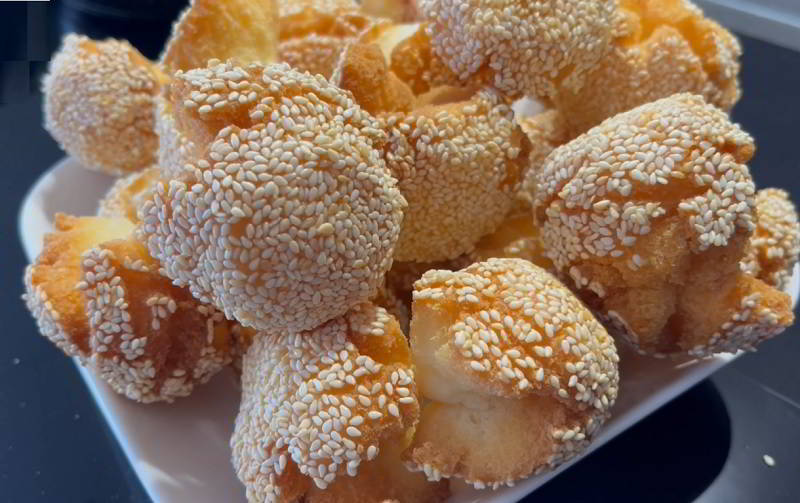
Binangkal is a popular Filipino dessert that originated from the Visayas region in the Philippines. It is a sweet and chewy dish that is loved by many for its simplicity and unique taste. The name "binangkal" is derived from the Visayan word "bangkal," which means to roll or shape into a ball. To make binangkal, a simple batter is prepared using flour, sugar, baking powder, and water. The mixture is then rolled into small balls and deep-fried until golden brown. The result is a crispy outer layer with a soft and chewy interior. Some variations of binangkal may include adding sesame seeds to the batter, giving the dessert a nutty flavor and a delightful crunch.
Otap
-1707810123.jpg)
Otap is a popular Filipino dessert that originated from the province of Cebu in the Philippines. It is a delicate and crispy puff pastry that is often enjoyed as a snack or after-meal treat. Made from flour, sugar, shortening, and margarine, otap is baked to perfection, resulting in a thin and flaky texture. The unique feature of otap is its distinct shape, resembling a thin, round biscuit with ridges on the outer edges. These ridges not only add a decorative touch but also contribute to the crispy texture of the dessert. Otap is usually sprinkled with sugar before baking, giving it a slightly sweet flavor.
Buko Salad
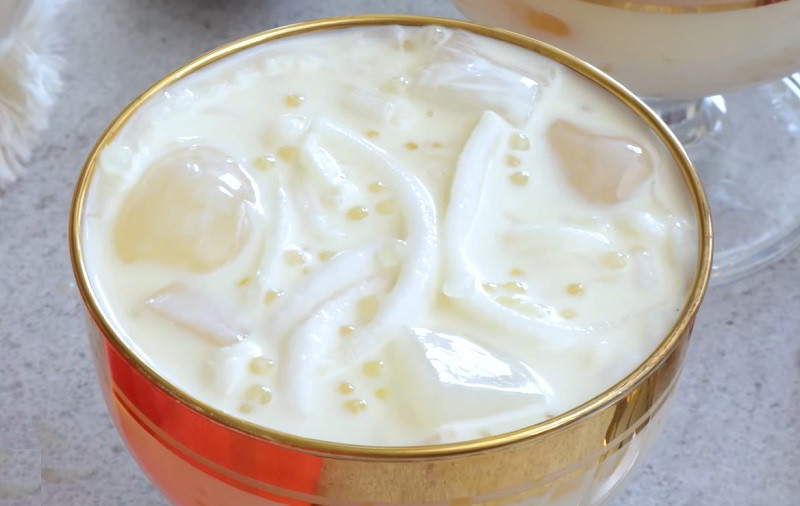
Buko salad is a popular Filipino dessert that showcases the tropical flavors of the Philippines. This delightful dish is made with a variety of ingredients, primarily fresh young coconut (buko), mixed with an assortment of fruits, cream, and sweetened condensed milk. The result is a creamy and refreshing dessert that is perfect for hot summer days or any special occasion. The star of the buko salad is the tender and juicy buko meat, which adds a subtle sweetness and a satisfying texture to the dish. It is often combined with a medley of fruits such as pineapple chunks, nata de coco (coconut jelly), and sweetened macapuno (coconut sport). These fruity components provide a burst of flavors and a vibrant appeal to the dessert. To bring everything together, the buko salad is generously coated with a creamy mixture of cream and sweetened condensed milk.
Ginataan
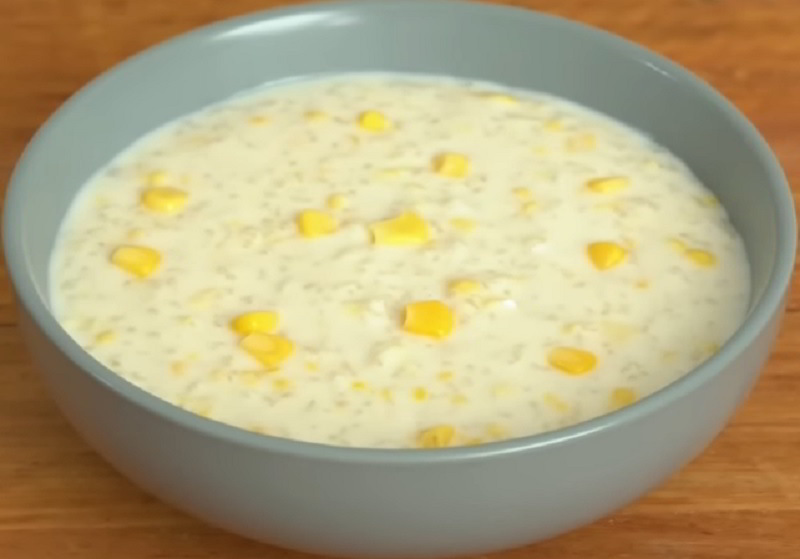
Ginataan, which translates to "cooked with coconut milk," is a popular traditional Filipino dessert that combines the richness of coconut milk with a variety of ingredients. This delectable dish is made by simmering various ingredients in coconut milk and sweetening it with sugar. The base of ginataan is the creamy and aromatic coconut milk, which gives the dessert its distinct flavor. It is then sweetened with sugar to balance the richness of the coconut milk. A wide range of ingredients can be added to ginataan, including sweet potatoes, taro, plantains, jackfruit, tapioca pearls, and glutinous rice balls. The result is a sweet and creamy dessert that is perfect for satisfying one's sweet tooth.
Bilo-bilo
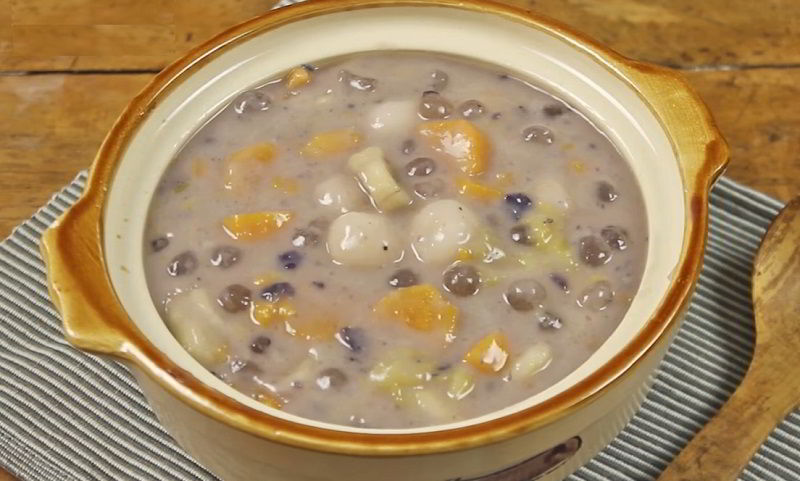
Bilo-bilo is a popular Filipino dessert made from sticky rice balls cooked in coconut milk with various ingredients. The main component of bilo-bilo is the glutinous rice balls, which are made by mixing glutinous rice flour with water to form a dough. The dough is then rolled into small balls, giving them their distinct chewy texture. These rice balls are cooked in a sweet coconut milk mixture until they become soft and translucent. In addition to the rice balls, bilo-bilo also includes a variety of other ingredients such as sweet potato, jackfruit, saba bananas, and tapioca pearls.
Binagol
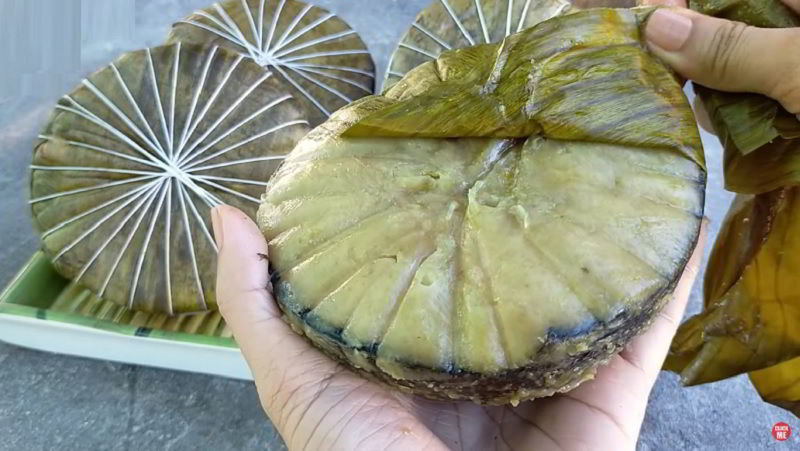
Binagol is a traditional Filipino dessert hailing from the province of Leyte in the Philippines. It is a delicious and unique sweet treat made from grated taro root (known as "gabi" in Filipino), coconut milk, brown sugar, and a variety of other ingredients. The dish gets its name from the way it is traditionally cooked and served - wrapped in banana leaves and shaped into a cone or pyramid-like shape. To make binagol, the taro root is grated and mixed with coconut milk and brown sugar, creating a sweet and creamy mixture. This mixture is then placed inside a banana leaf cone and topped with a layer of grated coconut meat. The cone is then steamed until the ingredients are cooked and melded together, resulting in a soft, sticky, and flavorful dessert. ines.
Sapin-sapin
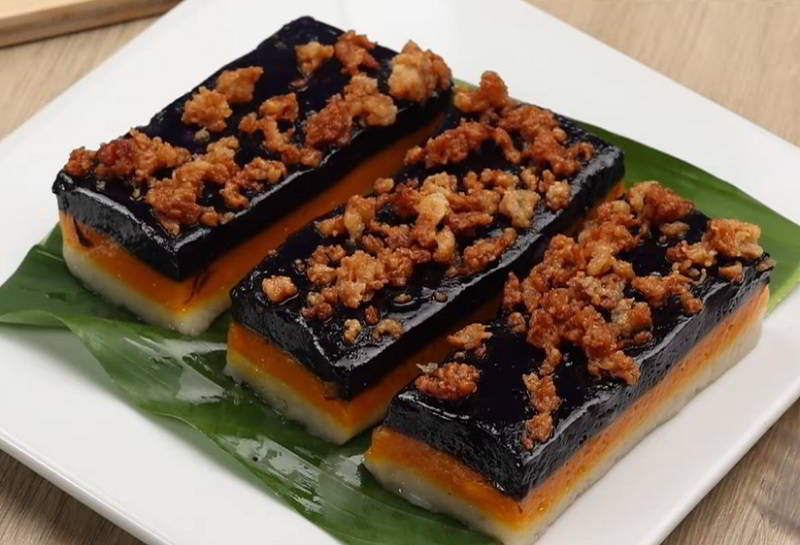
Sapin-sapin is a delectable Filipino dessert known for its vibrant and colorful layers. This traditional sweet treat is made from glutinous rice flour, coconut milk, sugar, and various flavorings. The name "sapin-sapin" literally translates to "layers" in Filipino, which perfectly describes its unique presentation. To make sapin-sapin, each layer is individually prepared by mixing the ingredients with different flavorings such as ube (purple yam), pandan (screwpine), and langka (jackfruit). The mixture is then steamed until cooked and set. Once all the layers are done, they are carefully stacked on top of each other, creating a beautiful rainbow effect. The texture of sapin-sapin is delightfully sticky and chewy, thanks to the glutinous rice flour. The flavors are sweet and fragrant, with the distinct taste of coconut shining through.
Barquillo
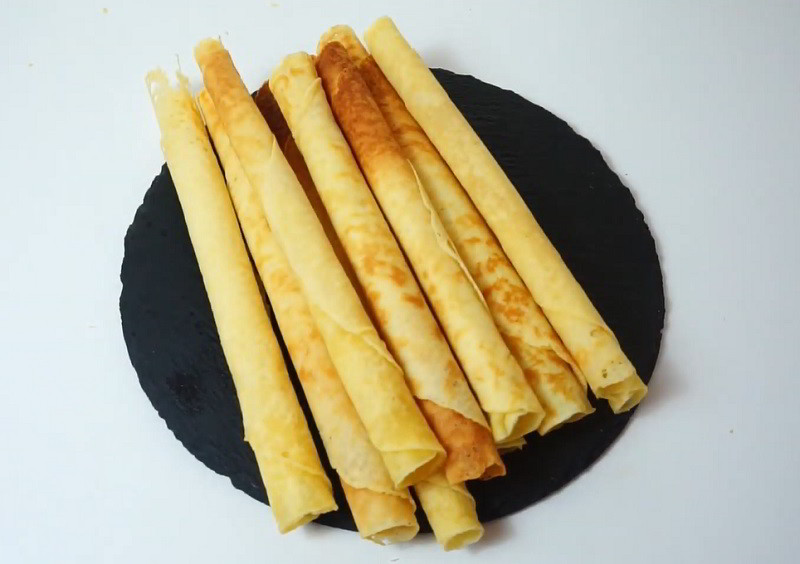
Barquillo is a traditional Filipino dessert that is loved for its crispy and delicate texture. The name "barquillo" is derived from the Spanish word for "wafer" and refers to the thin and cylindrical shape of the dessert. The main ingredient of barquillo is a thin batter made from flour, sugar, eggs, and butter. This batter is then spread thinly and evenly onto a hot, cylindrical mold, which is rotated to ensure even cooking. As the batter cooks, it transforms into a thin, crispy wafer that is rolled into a tube-like shape. Barquillo is often enjoyed on its own as a sweet treat, but it can also be used as a garnish or accompaniment for other desserts. Some popular variations of barquillo include filling it with sweetened coconut or chocolate spreads, adding a sprinkle of crushed peanuts, or drizzling it with caramel or chocolate sauce.
Nilupak
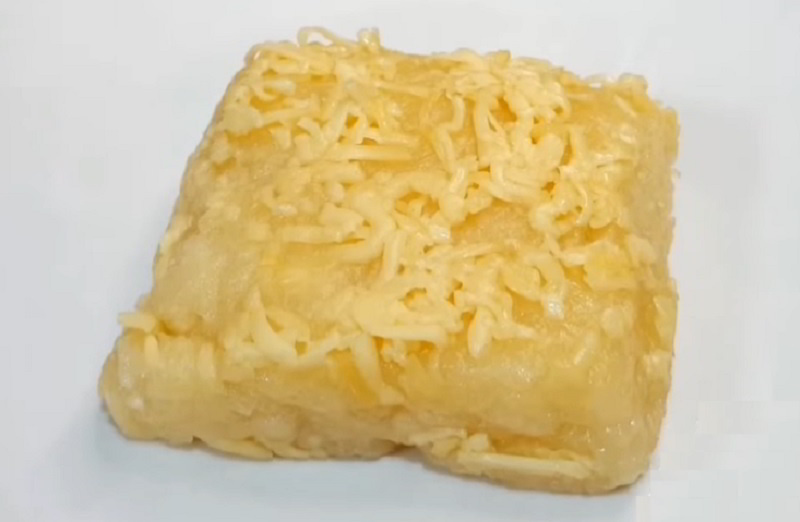
Nilupak is a traditional Filipino dessert that is made from mashed cassava or banana mixed with various ingredients to create a delicious and satisfying treat. The word "nilupak" comes from the Filipino word "lupak," which means to pound or mash. This dish is typically served as a snack or dessert and is popular in the Philippines. To make nilupak, the cassava or banana is boiled until soft, then mashed or pounded using a mortar and pestle. Sugar, condensed milk, and butter are added to enhance the sweetness and flavor. Some variations include adding grated coconut, jackfruit, or even chocolate for added texture and taste. The mixture is then shaped into small patties or balls and can be served as is or wrapped in banana leaves for added aroma. The final product is soft, creamy, and slightly sweet, with a unique texture that is both chewy and smooth.
Binaki
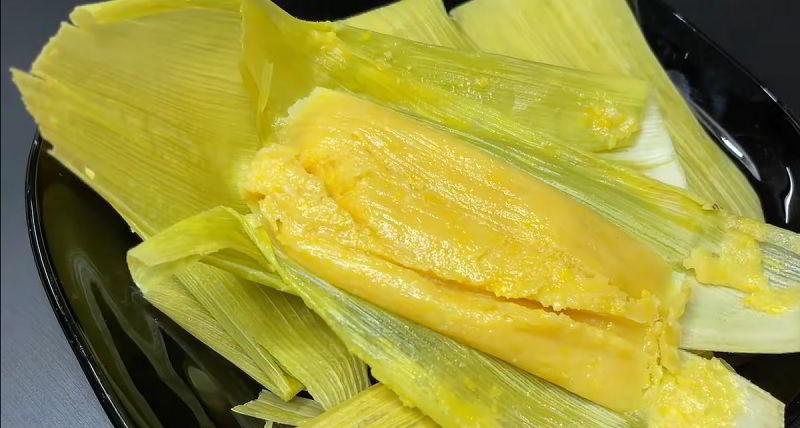
Binaki is a delectable tamale made by combining grated young corn, coconut milk, margarine, baking powder, and sugar. This special Filipino treat is usually steamed using corn husks or banana leaves, bringing out the delightful flavors of nixtamalized corn. Other delicious variations of binaki include the addition of condensed milk and cheese, which enhance its richness.
Flan Cake

The Flan Cake, also known as Leche Flan Cake or Caramel Cake, is a delectable Filipino dessert that combines the smoothness of flan with the sponginess of cake. The base of the Flan Cake is a layer of creamy, caramelized flan. This custard-like mixture is made from a combination of eggs, condensed milk, and vanilla extract. It is then poured into a baking pan and cooked until it sets and turns a beautiful golden color. On top of the flan layer, a light and moist vanilla chiffon cake is added. The cake batter is prepared separately, using ingredients like flour, sugar, eggs, and oil. Once baked, the cake is inverted onto the flan layer, creating a stunning two-layered dessert. The contrasting textures of the smooth and silky flan and the fluffy cake make each bite absolutely delightful. The caramel sauce from the flan seeps into the cake, adding a rich and sweet flavor.
Pichi-pichi
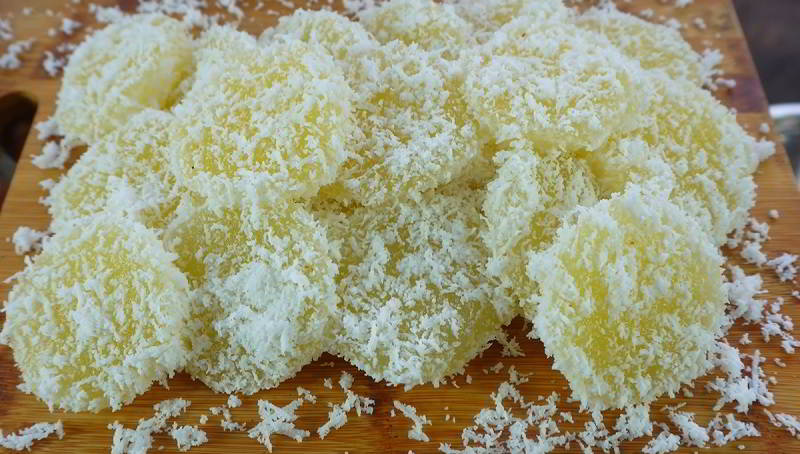
Pichi-pichi is a popular Filipino dessert known for its chewy and translucent texture. Made primarily from grated cassava and sugar, this delightful dish is steamed and then coated with grated coconut. The preparation of pichi-pichi starts with grating fresh cassava, which gives the dessert its distinct texture. The grated cassava is then mixed with sugar, water, and lye water, creating a sticky batter that is poured into individual molds. These molds are then placed in a steamer and cooked until the dessert becomes firm and translucent. Once cooked, the pichi-pichi is rolled in grated coconut, giving it a slightly nutty and sweet taste. The coconut adds a delightful contrast to the chewy texture of the cassava. Pichi-pichi can be enjoyed on its own or paired with other Filipino desserts like halo-halo or leche flan.
Egg Pie
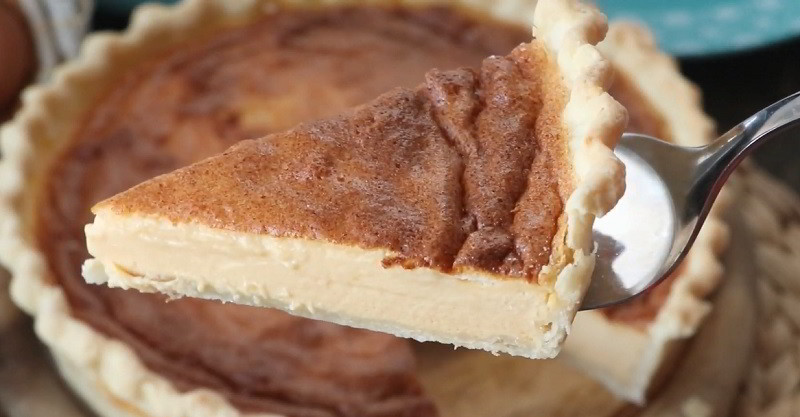
Egg pie is a popular dessert in the Philippines, known for its sweet and creamy custard filling and flaky crust. This delightful treat is a fusion of Filipino and American influences, with its origins tracing back to the American occupation of the Philippines. The pie crust is typically made with flour, butter, and sugar, resulting in a buttery and crumbly texture that perfectly complements the rich and velvety custard filling. The custard is made from a combination of eggs, condensed milk, evaporated milk, and vanilla extract, which gives it its distinct sweet and creamy flavor. Egg pie is often baked until the custard sets and turns a beautiful golden brown on top. The end result is a dessert that is both visually appealing and absolutely delicious.
Crema de fruta

Crema de fruta is a layered dessert made with a combination of creamy custard, soft sponge cake, fresh fruits, and gelatin. The name "crema de fruta" translates to "fruit cream" in English, perfectly describing the essence of this sweet treat. The first layer of the dessert is a soft sponge cake that provides a light and fluffy base. On top of the cake, a creamy custard layer is spread, adding a rich and smooth texture. The custard is then adorned with an array of colorful and juicy fruits such as peaches, cherries, and pineapples, giving the dessert a refreshing and tropical touch. To complete the dish, a layer of clear gelatin is poured over the fruits, adding a glossy and jelly-like finish.
Nata De Piña
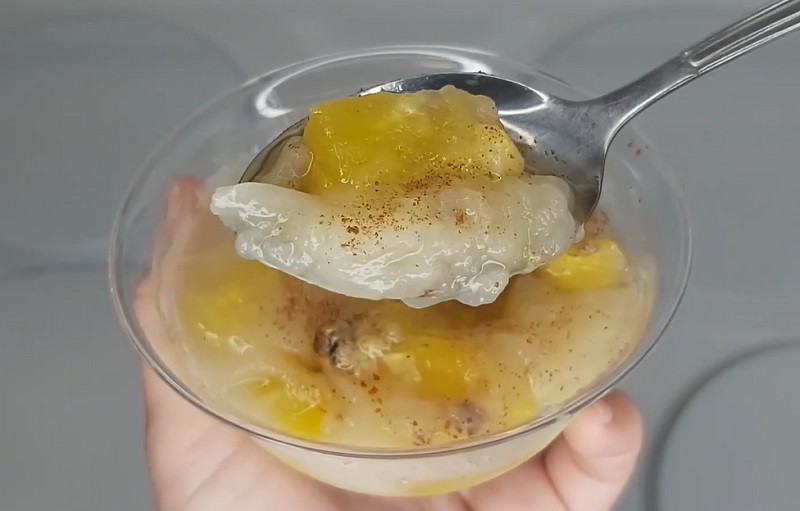
Nata de piña, a popular Philippine dessert, is a delightful treat made from fermented pineapple juice. It is known for its unique texture and sweet, tangy flavor. The word "nata" translates to "cream" in English, and true to its name, this dessert has a creamy, gelatin-like consistency. To make nata de piña, pineapple juice is mixed with a bacterial culture, which consumes the sugars in the juice and produces a gel-like substance. This substance is then cut into cubes or slices and served chilled. The resulting dessert is translucent, with a slightly chewy texture that is reminiscent of jelly. Nata de piña can be enjoyed on its own as a refreshing snack or used as an ingredient in various desserts and beverages. It is often added to halo-halo, a popular Filipino dessert that consists of shaved ice, sweet beans, fruits, and other toppings.
Panyalam
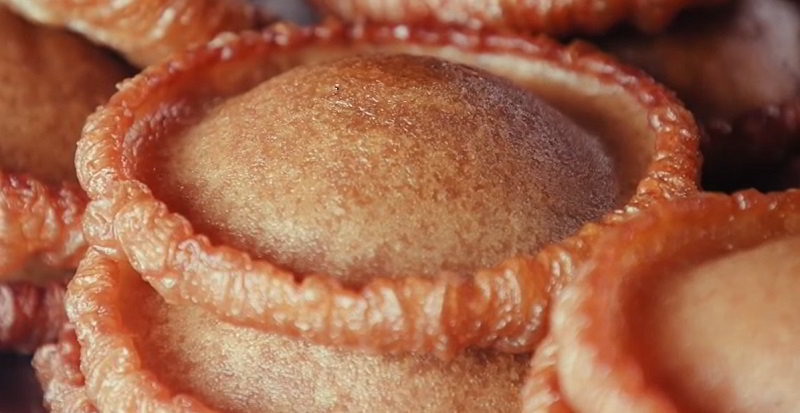
Panyalam is a delectable traditional dessert made using simple ingredients such as rice flour, coconut milk, sugar, and water. The dish is known for its light and fluffy texture, similar to a pancake or crepe. To make Panyalam, the rice flour is mixed with coconut milk and water to create a smooth batter. It is then cooked on a flat pan or griddle until it forms a thin, golden brown pancake. The pancake is then sprinkled with sugar, which adds a delightful sweetness to the dish. It can be served plain, or with various toppings such as shredded coconut, sweetened condensed milk, or even fresh fruits.
Espasol
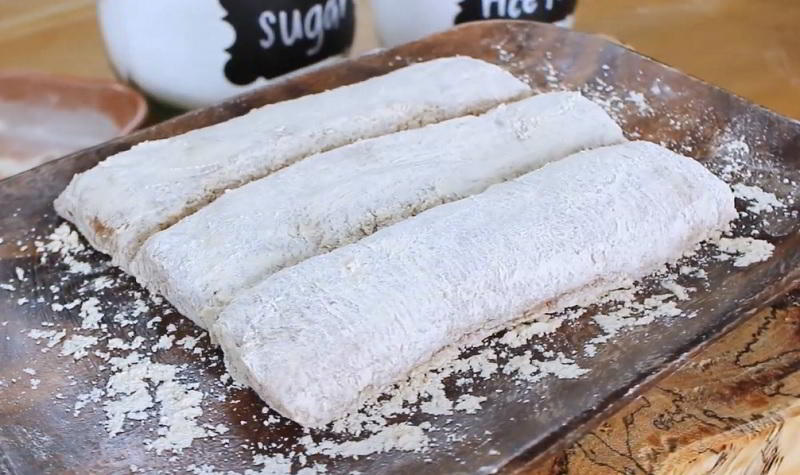
Espasol is a traditional Filipino dessert that originates from the province of Laguna in the Philippines. It is a cylindrical-shaped delicacy made from rice flour, coconut milk, and sugar. The dessert's distinctive texture is achieved by roasting the rice flour before mixing it with coconut milk, resulting in a slightly toasted and nutty flavor. To make espasol, the ingredients are cooked together in a pan until the mixture thickens and forms a dough-like consistency. The dough is then shaped into cylindrical logs and rolled in toasted rice flour to prevent sticking. The logs are typically wrapped in banana leaves for added aroma and presentation. Its chewy and slightly gritty texture, combined with the sweet and creamy coconut flavor, makes it a delightful treat.
Inipit
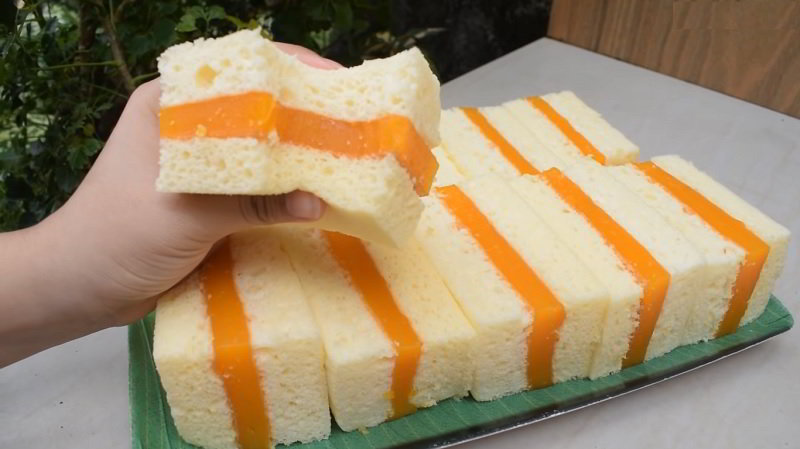
Inipit is a type of pastry made from two layers of soft and fluffy sponge cake, with a creamy filling in between. The name "inipit" comes from the Tagalog word "ipit," which means "to press" or "to squeeze," referring to the process of sandwiching the filling between the cake layers. The filling of inipit is typically made from butter, sugar, and milk, which are cooked together to create a smooth and creamy custard-like consistency. Some variations may also include flavors such as ube (purple yam) or pandan (screwpine) for a unique twist.
Pinasugbo
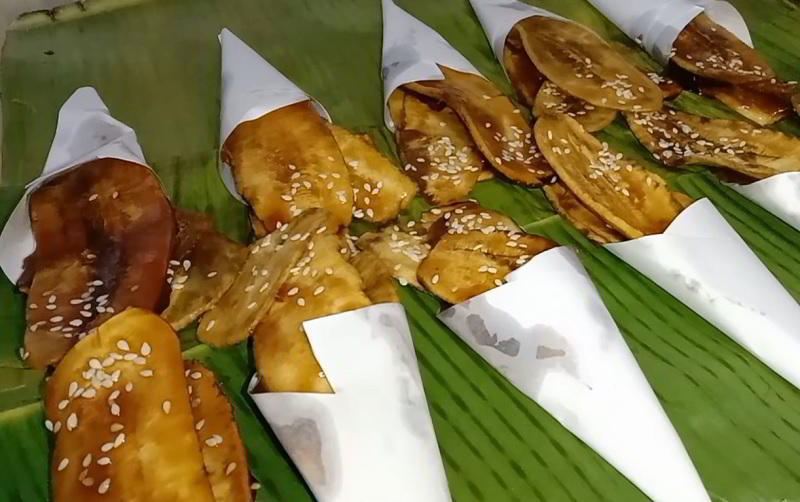
Pinasugbo is a sweet and crunchy delicacy made from ripe bananas, muscovado sugar, and sesame seeds. The name "Pinasugbo" is derived from the Cebuano words "pinasubo" and "sugbo," which mean "to bite" and "Cebu," respectively. To make Pinasugbo, the ripe bananas are peeled and sliced into bite-sized pieces. These banana slices are then coated in muscovado sugar, a type of unrefined brown sugar that adds a rich and caramel-like flavor. The coated banana slices are then fried until the sugar caramelizes and forms a crispy outer layer. Sesame seeds are sprinkled on top for added texture and nutty taste.
Palitaw
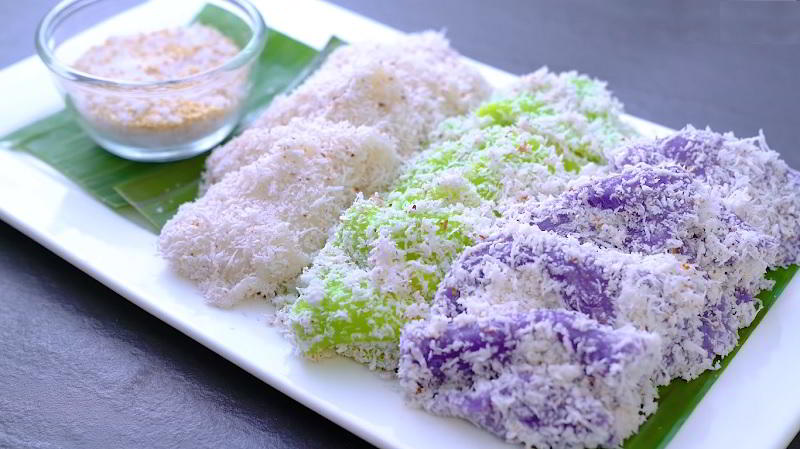
Palitaw is a traditional Filipino dessert that is both simple and delicious. The name "palitaw" is derived from the Filipino word "litaw," which means "to surface" or "to appear," referring to the way the dessert floats to the surface of boiling water when cooked. To make palitaw, a dough is prepared by combining glutinous rice flour and water until a smooth consistency is achieved. The dough is then rolled into small balls and flattened to form oval-shaped discs. These discs are then dropped into boiling water and cooked until they float to the surface. Once cooked, the palitaw is carefully lifted from the water and coated with grated coconut and toasted sesame seeds.
Kiping
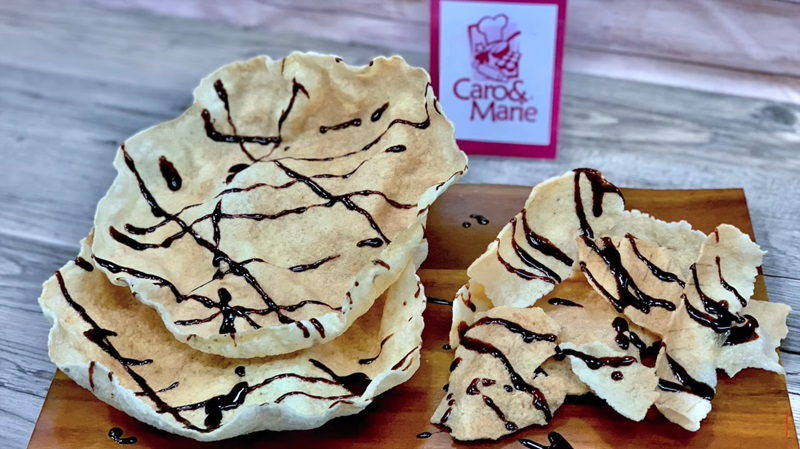
Kiping is a unique and delicious Filipino dessert that traces its origins to the province of Quezon in the Philippines. It is made from thin, translucent rice wafers that are shaped like leaves. The wafers are created by pounding a mixture of rice flour, water, and food coloring onto a banana leaf, which is then left to dry under the sun. Once the rice wafers are dried and crispy, they can be used in various ways. One popular method is to fold them into cone shapes and fill them with sweet fillings such as coconut jam, sweetened fruits, or even chocolate. Another way to enjoy kiping is by deep-frying the wafers until they turn golden brown and crispy, resulting in a delightful and crunchy snack.
Ginanggang
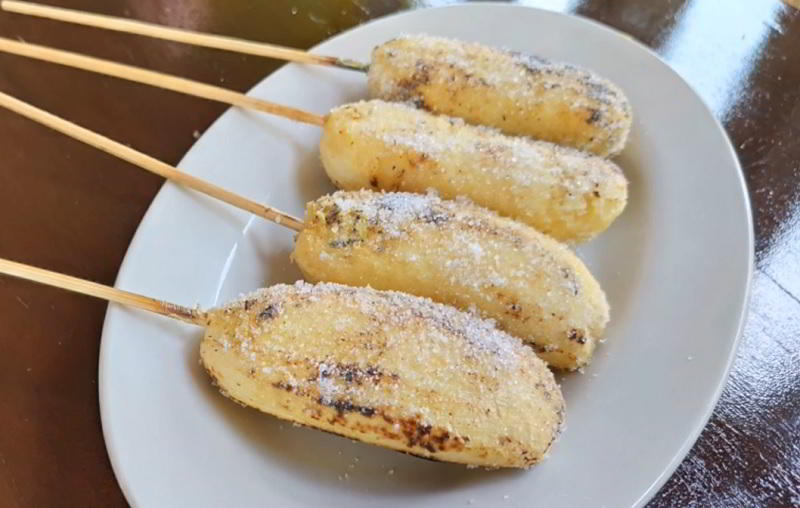
Ginanggang is a traditional Filipino dessert that originates from the southern region of the Philippines, particularly in Mindanao. It is a deliciously simple treat made from ripe bananas, which are grilled or roasted until they become soft and caramelized. The bananas are usually skewered on bamboo sticks, giving them a unique presentation. To make ginanggang, the bananas are first brushed with butter or margarine and then sprinkled with sugar or grated coconut before being grilled over charcoal. The heat from the grill enhances the natural sweetness of the bananas, resulting in a delightful smoky flavor. Once cooked, the bananas are often served with a side of butter or margarine and a sprinkling of more sugar or grated coconut.
Maíz Con Hielo
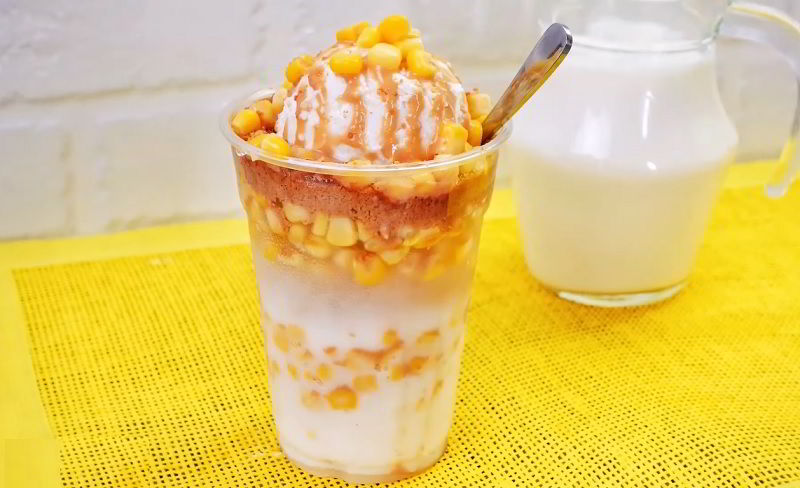
Maíz con hielo is a popular and refreshing Filipino dessert that is perfect for beating the tropical heat. The name itself translates to "corn with ice," and it is just as simple and delicious as it sounds. The star ingredient of this dessert is sweet corn kernels, which are cooked until tender and then chilled. The corn is then combined with crushed ice, creating a delightful contrast of textures. To add another layer of flavor, sweetened condensed milk is drizzled over the top, giving the dessert a creamy and indulgent touch. Maíz con hielo is often served in tall glasses or bowls, making it visually appealing and easy to enjoy. It is a versatile dessert that can be customized to suit individual preferences. Some variations include adding sliced fruits like mango, jackfruit, or banana, as well as cooked sago pearls or jelly cubes for added texture.
Galletas de patatas
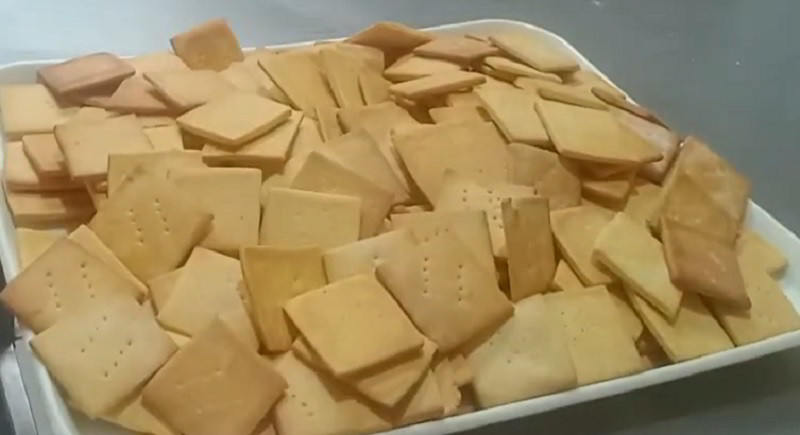
Galletas de patatas is a delightful Philippine dessert that is sure to satisfy your sweet tooth. Originating from the province of Batangas, this dessert is made from simple ingredients such as potatoes, sugar, butter, egg yolks, and flour. To prepare galletas de patatas, the potatoes are boiled until they are soft and then mashed into a smooth consistency. The mashed potatoes are then mixed with sugar, butter, and egg yolks to create a rich and creamy batter. Finally, flour is added to the mixture to form a dough that is shaped into small round cookies. These cookies are then baked until they turn golden brown and develop a crispy texture on the outside, while remaining soft and chewy on the inside. Galletas de patatas have a delicate sweetness that is perfectly balanced with a hint of savory flavor from the potatoes.
Camote Cue
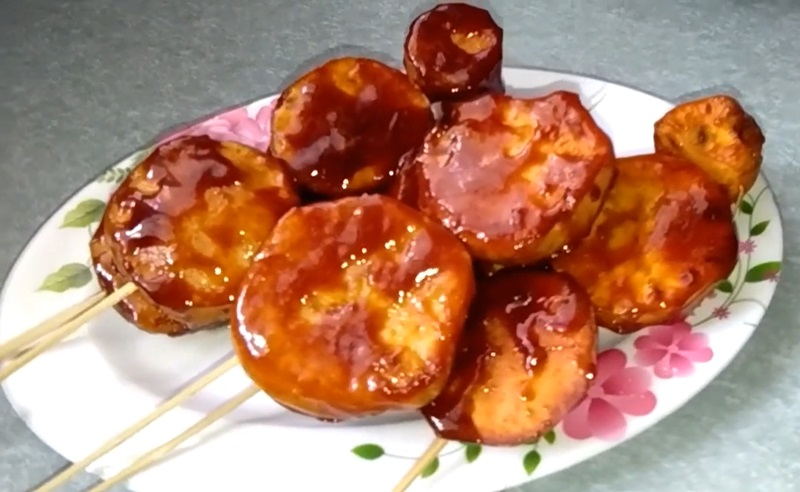
Camote Cue is a popular Filipino dessert made from deep-fried sweet potatoes. The name "camote cue" is derived from the Filipino word "kamote," which means sweet potato, and "cue," which refers to the act of skewering or sticking. To prepare camote cue, sweet potatoes are first peeled and sliced into thick rounds. These slices are then coated in brown sugar, giving them a sweet and caramelized flavor. The coated sweet potato slices are then skewered onto bamboo sticks and deep-fried until golden and crispy. The end result is a delicious treat with a perfect balance of sweetness and crunchiness. The brown sugar caramelizes during frying, creating a sticky and sweet coating that complements the soft and tender sweet potato inside.
Yema Cake

Yema cake is a delicious and indulgent Filipino dessert that combines two beloved treats: yema and cake. Yema, which means "egg yolks" in Spanish, is a popular sweet in the Philippines made from condensed milk and egg yolks. The yema mixture is typically cooked until it thickens and then shaped into bite-sized balls. Yema cake takes this traditional yema and elevates it by incorporating it into a soft and moist chiffon cake. The cake layers are filled and frosted with a luscious yema icing, giving it a rich and creamy texture. The cake is often topped with grated cheese or caramelized sugar for added sweetness and flavor.
Queso Ice Cream
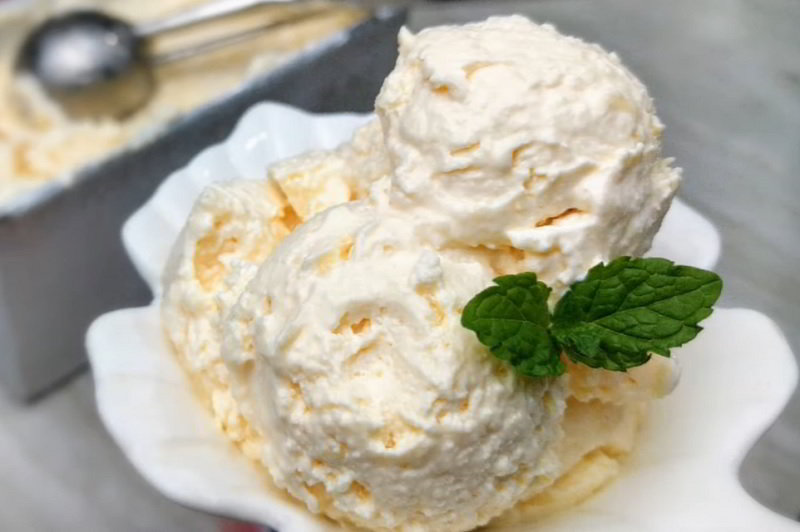
Queso ice cream is a popular Filipino dessert that combines the sweetness of ice cream with the savory goodness of cheese. It is a unique and delicious treat that is loved by many. The base of queso ice cream is typically a rich and creamy vanilla ice cream, which provides the perfect canvas for the addition of cheese. The cheese used can vary, but it is often a mild and creamy cheese such as queso de bola or Edam cheese. The cheese is grated or finely chopped and then mixed into the ice cream mixture. The result is a smooth and velvety ice cream with a subtle hint of cheese flavor. The sweetness of the ice cream is balanced by the slight saltiness and richness of the cheese, creating a delightful combination of flavors.
Baye Baye
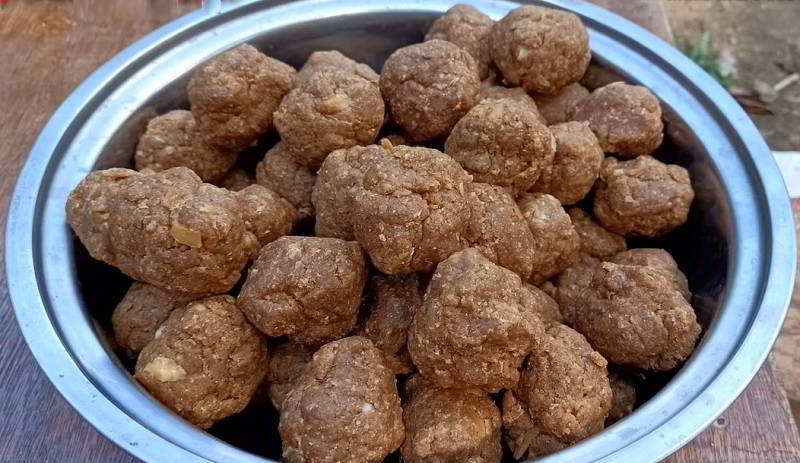
Baye Baye is a classic Filipino sweet made by blending grated young coconut with either corn patties or pounded young rice flakes known as pinipig. To prepare, the pinipig is toasted until golden, then ground and mixed with coconut water, sugar, and grated young coconut. This mixture is then shaped into logs and wrapped in banana leaves. After chilling to solidify, the dessert is ready to be enjoyed. This delightful treat offers a harmonious blend of flavors and textures,
Pastel de Camiguín
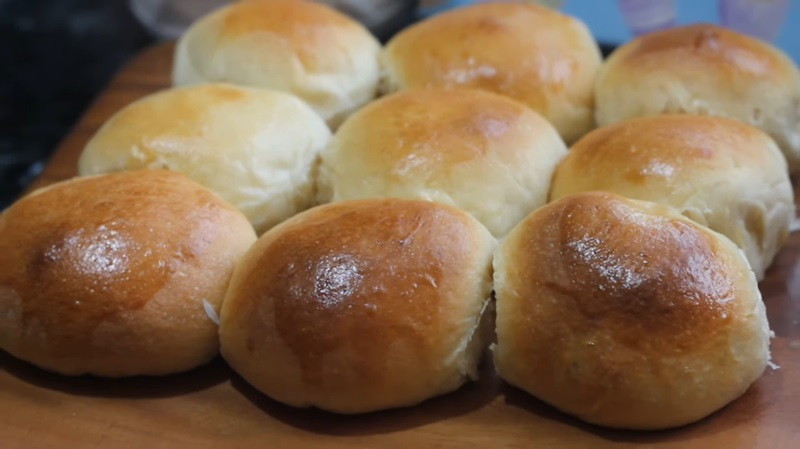
Pastel de Camiguín is a delectable Filipino dessert hailing from the island of Camiguín in the Philippines. This mouthwatering treat is a type of custard-filled pastry that is both rich and indulgent. The main component of Pastel de Camiguín is the soft and buttery pastry crust. It is made from a mixture of flour, sugar, butter, and eggs, resulting in a flaky and slightly sweet base. The crust is then filled with a luscious custard filling, which is made from a combination of milk, eggs, sugar, and vanilla extract. The custard is creamy and velvety, with a hint of sweetness that perfectly complements the pastry. What sets Pastel de Camiguín apart is the addition of a special ingredient – yema. Yema is a traditional Filipino sweet made from condensed milk and egg yolks, and it is added to the custard filling to give it an extra layer of richness and flavor.
Cascaron
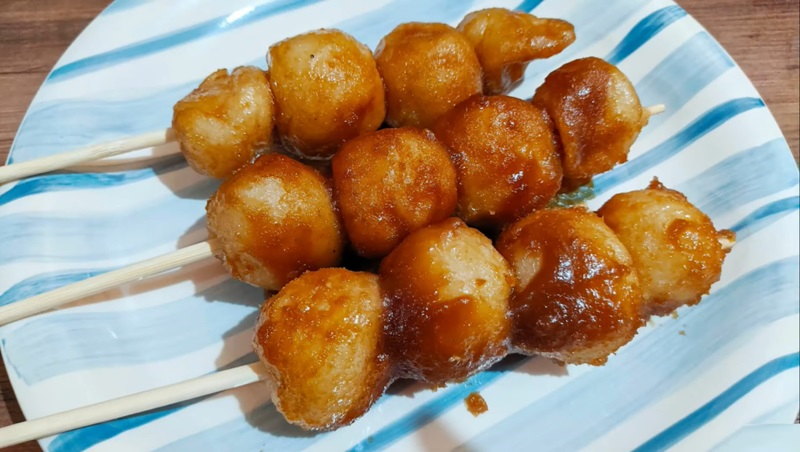
Cascaron is a Filipino pastry made from deep-fried mixture of ground glutinous rice, grated coconut, and sugar. They are typically spherical, resembling small balls, and are often sold skewered. However, they can also take on elongated, pancake-like, or doughnut-shaped forms. The name "cascaron" is influenced by Spanish, derived from "cascarón," meaning "eggshell," owing to its common round shape and crunchy outer layer.
Kabkab
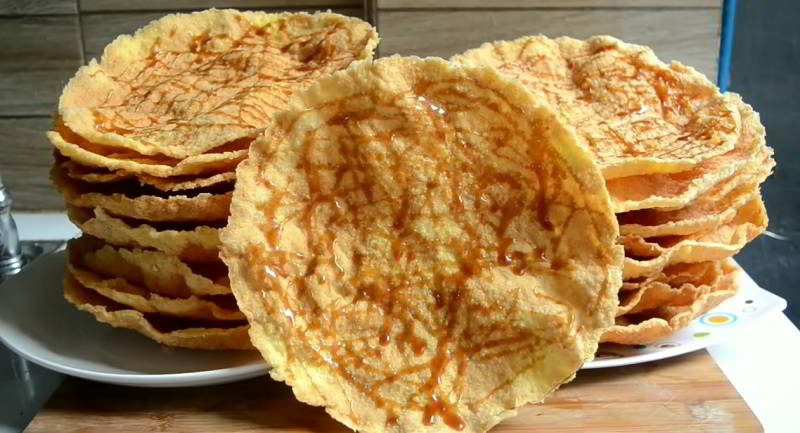
Kabkab, also referred to as cassava cracker or cassava crisp, is a cherished Filipino delicacy originating from Mindanao and the southern Visayan islands. It's prepared by finely mashing cassava tubers with a touch of salt and sugar. This mixture is spread thinly on banana leaves and steamed until the cassava turns translucent and gains a paste-like consistency. Afterward, it's left to air-dry or sun-dry until it reaches a crispy, firm texture. Kabkab is typically enjoyed as a dessert, often served with a drizzle of latik, a sweet coconut caramel sauce, adding a delightful finishing touch to its delicious flavor.
Masi
-1707902085.jpg)
Masi is a delectable treat originating from Cebu, Philippines, consisting of glutinous rice balls filled with a mixture of peanuts and muscovado sugar. Sweetened ground glutinous rice is shaped into small balls, filled with the peanut-sugar blend, and boiled or steamed until they float. Traditionally, they're wrapped in banana leaves for serving. Variations include fillings like chocolate or peanut butter, and coconut milk can be added for a creamier dough.
Iskrambol

Iskrambol, or ice scramble, is a popular frozen treat originating from the Philippines. It features shaved ice flavored with banana extract and mixed with evaporated milk and sugar (or condensed milk). Toppings vary widely and can include powdered milk, marshmallows, syrups, pinipig, tapioca pearls, and sprinkles. Typically, the banana-flavored version is dyed pink, while other flavors may have different colors.
Ube Cheesecake
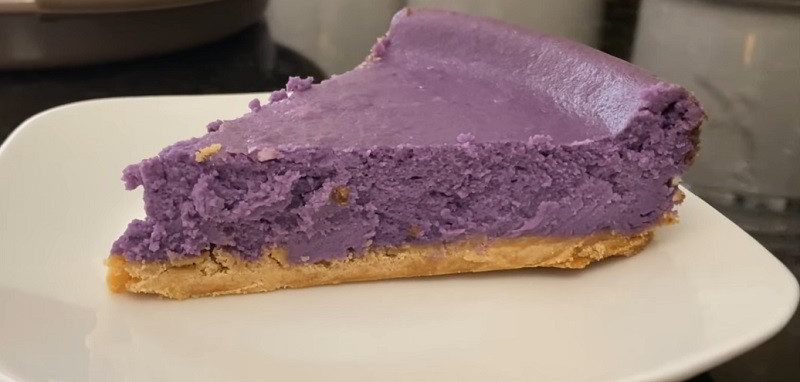
Ube cheesecake, also known as purple yam cheesecake, is a delightful Filipino dessert. Its crust is typically crafted from crushed graham crackers, while its creamy upper layer combines cream cheese with ube halaya, a sweet mashed purple yam mixture. This cheesecake can be baked or chilled, resulting in a luscious treat. It is typically purple in colour.
Moche
-1707908302.jpg)
Moche are traditional Filipino treats consisting of glutinous rice balls filled with bean paste. They're crafted from ground-soaked glutinous rice and stuffed with either mung bean or red bean paste, though sometimes caramel grated coconut, known as bukayo, is used. Shaped into balls or ovals, they're boiled until they float, then garnished with sesame seeds or crushed peanuts. Typically served hot, moche are accompanied by a sweetened coconut milk sauce known as gata.
Daral
-1707909295.jpg)
Daral is a traditional Filipino dessert resembling a rolled crêpe. Originating from the Tausug community in the Philippines, it features a cylinder-shaped wrap filled with sweetened coconut meat known as hinti. Occasionally, the wrap is infused with the fragrance of pandan leaves, enhancing its flavor profile.
Sayongsong
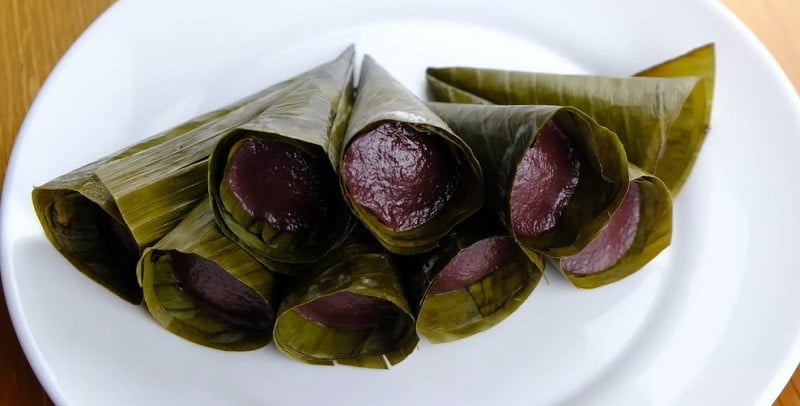
Sayongsong is a delectable Filipino dessert made from glutinous rice flour mixed with coconut milk, sugar, and ground peanuts, then wrapped in banana leaves and steamed until cooked. The process of making Sayongsong begins with the preparation of the sticky rice mixture, which is then formed into small, rectangular shapes. These rice cakes are then wrapped tightly in banana leaves, which impart a subtle aroma and flavor to the dessert when cooked. Once steamed, Sayongsong develops a soft and slightly chewy texture, with a delicate sweetness that is enhanced by the nutty flavor of ground peanuts.
Rosquillo
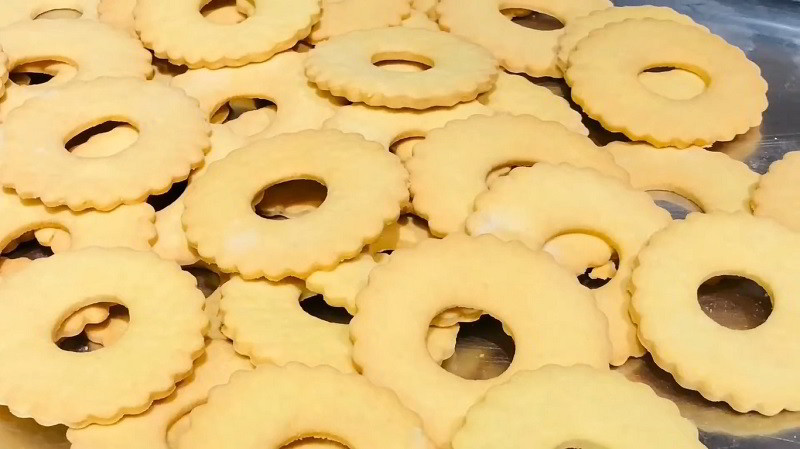
Rosquillos is a traditional Filipino dessert that originated from the province of Cebu in the Philippines. It is a delicate and crumbly cookie that is shaped like a ring, giving it its distinctive appearance. The name "rosquillos" is derived from the Spanish word "rosca," which means ring. The ingredients used in making rosquillos are simple and readily available. It typically includes flour, sugar, eggs, butter, and baking powder. The dough is mixed and shaped into small rings before being baked until golden brown. The result is a buttery and melt-in-your-mouth cookie with a slightly sweet and vanilla-like flavor.
Lamaw
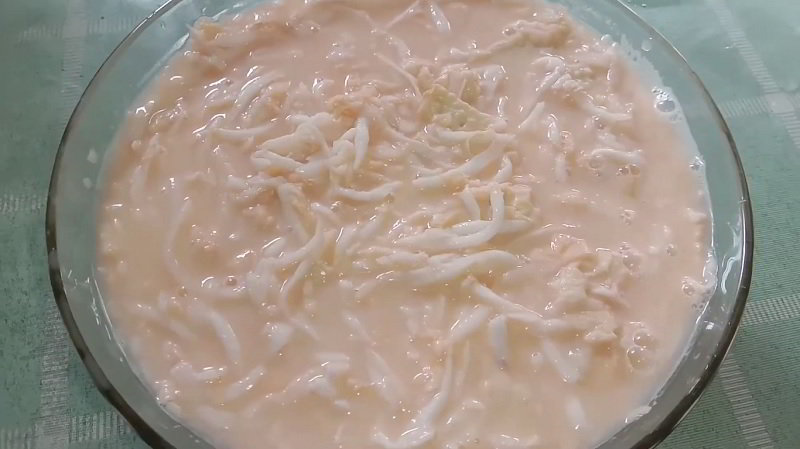
Lamaw, also referred to as buko lamaw, is a Filipino delicacy enjoyed either as a dessert or a beverage. It consists of scraped young coconut meat (known as buko) combined with coconut water, milk, sugar, and often saltines or biscuits. Additional variations may include peanuts, graham crackers, or even orange-flavored soft drinks for a unique twist. Typically served chilled with ice cubes, lamaw is commonly prepared using freshly harvested coconuts and often presented within the natural shell of the coconut itself.
Ube crinkles
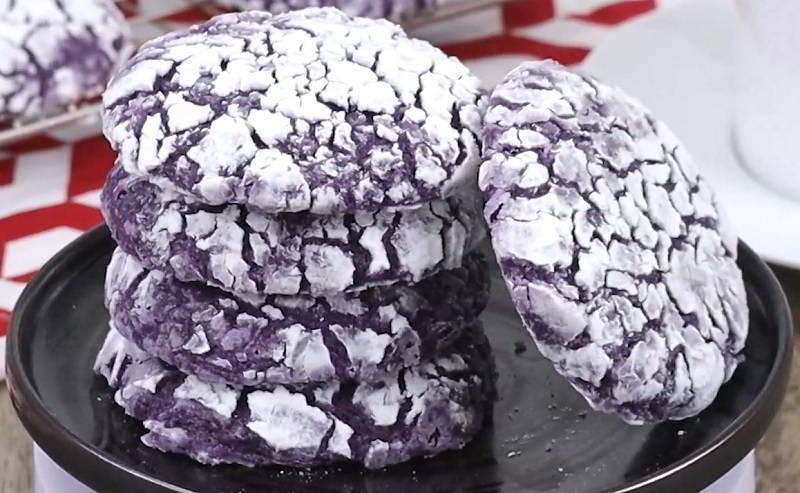
Ube crinkles is a delightful Filipino dessert that is loved by many for its vibrant purple color and delectable taste. This dessert is made from ube, a purple yam that is commonly used in Filipino cuisine. The ube is mashed and mixed with flour, sugar, eggs, and butter to create a soft and chewy cookie dough. Once the dough is prepared, it is rolled into small balls and coated generously with powdered sugar. As the cookies bake, they develop a crackled appearance on the outside, giving them their signature crinkle texture. The result is a batch of irresistible cookies that are crispy on the outside and soft on the inside.
Salukara
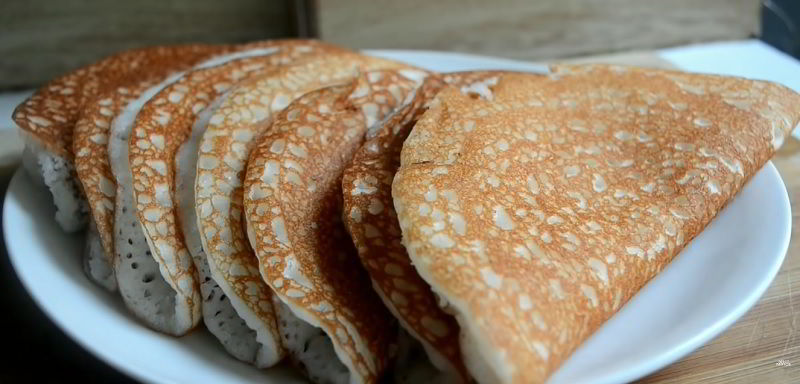
Salukara is pancake made up of glutinous rice flour, sugar, coconut milk, and water. Traditionally, tuba or palm wine provides leavening, offering a subtle sour note, but baker's yeast can be substituted. Salukara is cooked on a pan or clay pot, with banana leaf lining.
Minatamis na Saging
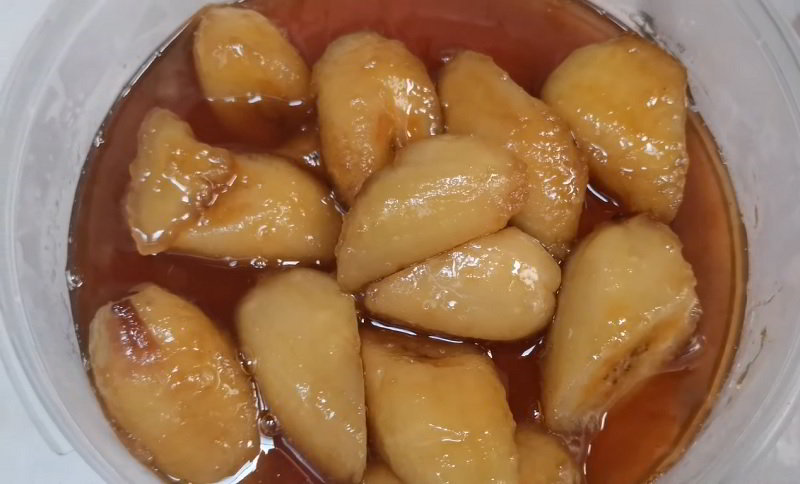
Minatamis na Saging is a traditional Filipino dessert that showcases the rich flavors of bananas cooked in a sweet syrup. This delectable treat starts with ripe saba bananas, which are known for their starchy texture and subtle sweetness. The bananas are sliced into bite-sized pieces and then cooked in a thick syrup made from caramelized brown sugar and water. As the bananas simmer in the syrup, they absorb the sweet flavors and become soft and tender. The syrup thickens and coats the bananas, creating a sticky and luscious caramel coating. Some variations of minatamis na saging also include the addition of pandan leaves or vanilla extract to enhance the flavor profile.
Abukado Lamaw
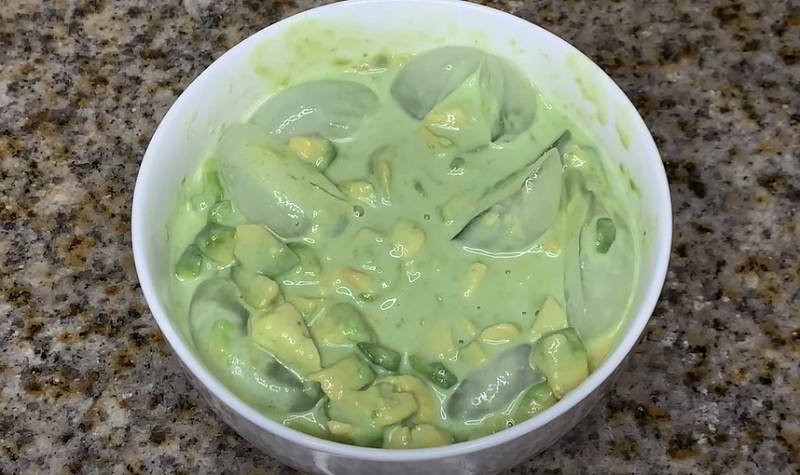
Abukado lamaw is a classic Filipino dessert made from avocado blended with milk and sugar. Variations may involve condensed milk, evaporated milk, or powdered milk. Best enjoyed chilled, it's often served with shaved or crushed ice, or partly frozen. Some recipes skip the milk, directly mixing avocados with sugar for a delightful refreshment.
Apas
-1707913260.jpg)
Apas are thin, oblong-shaped biscuits adorned with a dusting of sugar, renowned in Quezon. Crafted from a blend of flour, milk, eggs, sugar, and butter, they boast a subtle flavor profile. Often paired with hot beverages, these biscuits offer a delightful treat to accompany your drink.
Ginataang Mais
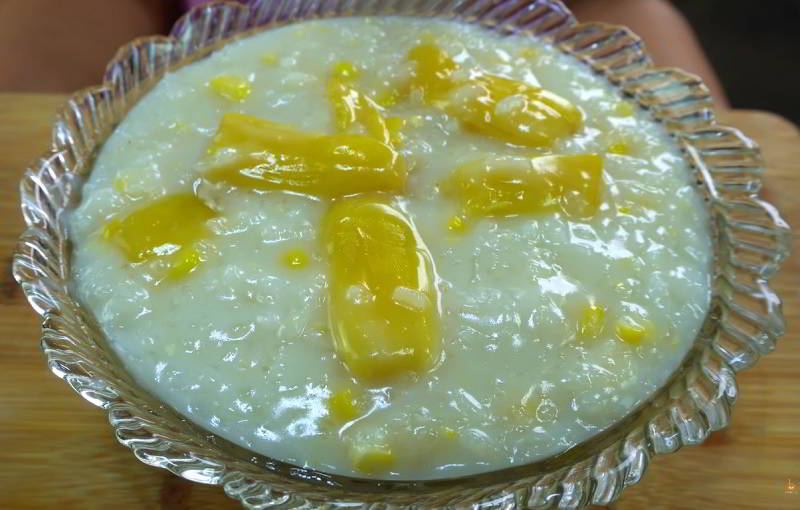
Ginataang mais, also known as coconut milk and corn pudding, is a delightful Filipino dessert that showcases the rich flavors of coconut and the sweetness of corn. This traditional dish is made by combining glutinous rice, coconut milk, sugar, and sweet corn kernels, resulting in a creamy and comforting dessert. The process begins by simmering glutinous rice in coconut milk until it becomes soft and sticky. Then, sweet corn kernels are added, giving the dish a burst of sweetness and a delightful crunch. Sugar is then added to enhance the overall sweetness and balance the flavors.
Mango Cake

Mango Cake is a beloved Filipino dessert featuring layers of chiffon cake infused with luscious Carabao mangoes. Often adorned with mango cream frosting, fresh mango slices, or mango puree in gelatin, it's a delightful treat. Additional toppings like cream, cream cheese, and chocolate are also common, while slices of mango are frequently sandwiched between the layers.
Ginataang Munggo
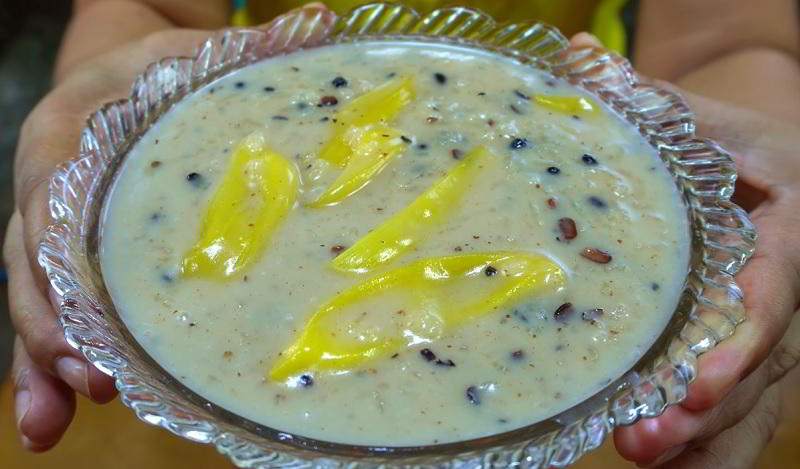
Ginataang munggo is a traditional Filipino dessert made from mung beans cooked in coconut milk. This sweet and creamy dish is a popular treat enjoyed by many Filipinos. To prepare ginataang munggo, the mung beans are first soaked overnight and then boiled until they become soft and tender. The cooked beans are then combined with coconut milk, sugar, and sometimes sliced bananas or sweet potatoes. The mixture is simmered until all the flavors meld together, creating a luscious and aromatic dessert.
Paborita
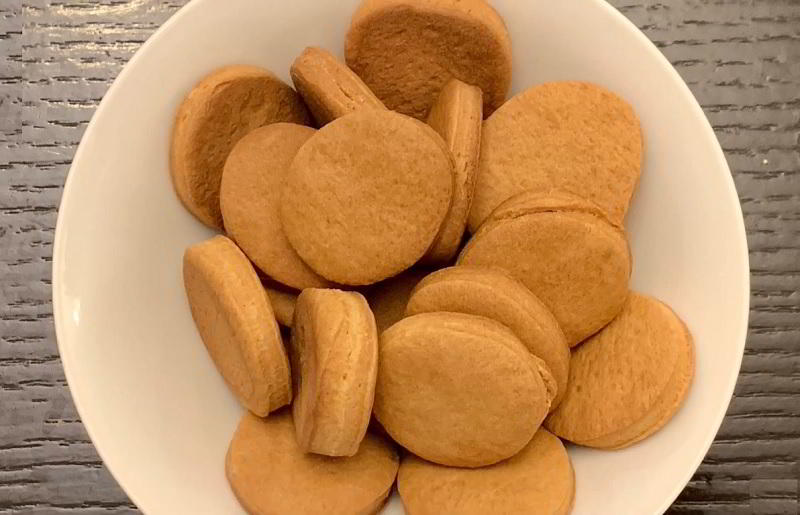
Paborita are circular Filipino biscuits known for their flaky texture. Made from a mixture of wheat flour, sugar, skim milk, salt, baking powder, alum, and cooking oil, these treats offer a delightful crunch with every bite.
Mache

Mache are glutinous rice balls, typically plain or infused with coconut and pandan flavors. They're crafted from boiled galapong (ground soaked glutinous rice), sometimes mixed with pandan flavoring. Each ball is filled with toasted sesame seeds and sugar, then coated in glutinous rice flour or powdered sugar for added sweetness. These treats are known for their white or green hue, depending on the presence of pandan extracts.
Putli Mandi
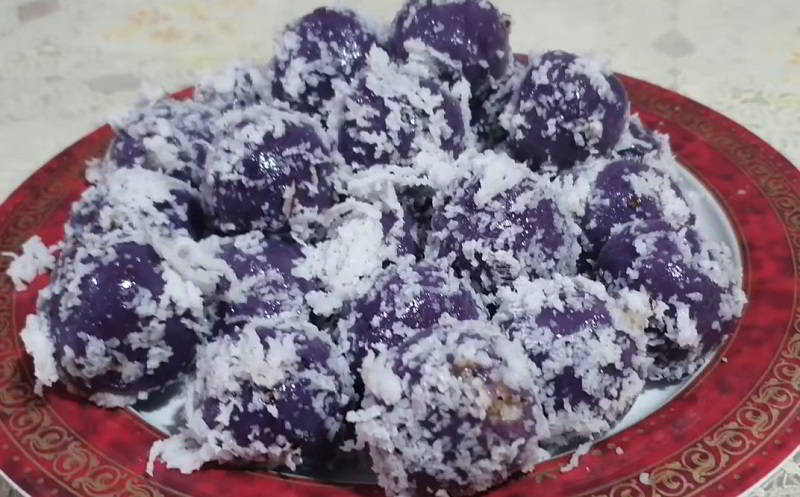
Putli mandi is a steamed rice cake originating from the Tausug and Yakan communities in Sulu, Philippines. It's made from glutinous rice dough, although cassava can also be used, rolled into balls and filled with sweetened coconut strips called hinti. Traditionally, it's made with pulut glutinous rice, lending it a natural deep purple hue, although modern versions may be dyed. Before serving, it's adorned with fresh grated coconut.


